

Unlocking Language Skills English Coursebook






Melanie Grobler is a seasoned education professional with experience spanning over three decades in the field of ELT curriculum development and assessment. She has worked in senior advisory positions in India for 10 years and has developed several K-8 ELT products. In South Africa, she served as national examiner for the Class 12 Exit Examination and worked as a teacher, college and university lecturer and subject advisor.

Chandani Goyal, is an English Language Teaching (ELT) educator with over 9 years of experience in renowned schools like Heritage Xperiential Learning School, Ahlcon International School and Amity International School. She is also a published author of articles on classroom intervention and pedagogy. She brings a deep understanding of methodology and approaches to language learning into the compilation of this book, enhancing its effectiveness for educators and learners alike.
Academic Authors: Melanie Grobler, Chandani Goyal, Anuj Gupta
Creative Directors: Bhavna Tripathi, Mangal Singh Rana, Satish
Book Production: Rakesh Kumar Singh
Project Lead: Chandani Goyal
VP, Learning: Abhishek Bhatnagar
All products and brand names used in this book are trademarks, registered trademarks or trade names of their respective owners.
© Uolo EdTech Private Limited
First impression 2025
This book is sold subject to the condition that it shall not by way of trade or otherwise, be lent, resold, hired out, or otherwise circulated without the publisher’s prior written consent in any form of binding or cover other than that in which it is published and without a similar condition including this condition being imposed on the subsequent purchaser and without limiting the rights under copyright reserved above, no part of this publication may be reproduced, stored in or introduced into a retrieval system, or transmitted in any form or by any means, electronic, mechanical, photocopying, recording or otherwise, without the prior written permission of both the copyright owner and the above-mentioned publisher of this book.
Book Title: Ignite English Coursebook 2
ISBN: 978-81-980680-5-7
Published by Uolo EdTech Private Limited
Corporate Office Address:
85, Sector 44, Gurugram, Haryana 122003
CIN: U74999DL2017PTC322986
Illustrations and images: www.shutterstock.com, www.stock.adobe.com and www.freepik.com
All suggested use of the internet should be under adult supervision.
The ability to understand and communicate effectively in English remains a vital tool for success in today’s globalized world. Research by the World Economic Forum, in their Future of Jobs Report 2023, highlights that strong communication skills are among the top skills required for the workforce of the future. These skills ensure lifelong learning and facilitate successful entry into the professional world. This is in keeping with the vision of the National Education Policy (NEP) 2020 and National Curriculum Framework (NCF) 2022–23 which focusses on preparing learners for a dynamic future.
Guided by the visionary principles outlined in the NEP 2020 and NCF 2022–23, education in India is undergoing significant transformation. There is a focus on a holistic, flexible, and multidisciplinary education, which aims to nurture 21st century soft skills such as effective communication, creativity, critical thinking and problem solving.
Following the directives of these landmark documents, Ignite is an ELT programme designed especially for 21st century learners. It develops foundational language skills—listening, speaking, reading, and writing—in a systematic and engaging way. In keeping with the NEP 2020’s focus on holistic education, Ignite provides ample opportunities for learners to practise the recommended soft skills. The programme’s task-based approach and frequent opportunities for collaborative learning, encourage learners to express themselves creatively, interact constructively, take responsibility for their own learning, solve problems effectively and apply their knowledge in new situations. With a strong focus on socio-emotional learning (SEL) and the awareness of Sustainable Development Goals (SDGs), Ignite fosters national pride and good citizenship while also exposing learners to global perspectives.
In today’s media-rich environment, the ability to interpret, analyse, and create visual content is essential. Ignite develops learners’ skills to understand and communicate through images, symbols, and visual texts, preparing them to navigate and contribute to the increasingly visual world they live in. In accordance with the NEP 2020’s emphasis on continuous and comprehensive assessment, Ignite supports ongoing learning by empowering learners, parents and teachers with the tools to track and enhance learning.
Ignite offers a balanced approach to listening, speaking, reading and writing that respects the linguistic diversity of learners while providing them with the tools to master the English language. The rubrics in the Teacher Guide emphasize the importance of creativity, the ability to find and express alternative solutions, innovation, teamwork, perseverance and work ethics.
We extend our warmest wishes to all educators, parents and learners as they embark on the exciting Ignite journey, filled with fun and joyful experiences. Let us work together to prepare our learners not just for the world as it is, but for the world as it could be, where they will thrive as empathetic, innovative and responsible global citizens.
Welcome to the Ignite journey!
The programme is an activities-based learning experience that builds language (LSRW) skills. It also emphasizes the development of critical soft skills and provides ample opportunities for formative and summative assessment. The Coursebook and the Workbook are a mix of rich LSRW experiences that can be teacher-led or done at home. Ignite prepares learners for a future where they can navigate and contribute to a rapidly evolving world.
Coursebook
Workbook
Teacher Guide
Papers
Hands-On Projects
Progress Tracker
Student and Teacher Apps
Talking Books
Pronounce Well
Listen Well
Speak Well
The classroom programme is augmented by the digital world, which is presented to the learners through the UOLO App. The app includes projects that are closely associated with the activities in the Coursebook. The projects provide children with fear-free practice time at home. The app also includes interactive activities in listening, speaking, reading and writing.

The National Education Policy (NEP) 2020, introduced by the Government of India, represents a transformative shift in the country’s education system. It aims to create a more holistic, dynamic and multidisciplinary approach to education. The NEP 2020 focusses on fostering conceptual understanding, skills, values and competencies that align with the demands of the 21st century, while also preserving India’s rich cultural heritage. UOLO is committed to actualizing the vision of the NEP 2020 by meticulously adhering to its outlined recommendations.











1. Language (LSRW) skills building
2. 21st century skills, values and dispositions
3. Creative and critical thinking
4. Application in real life
5. Holistic and integrated learning
6. Learning by doing
7. Enjoyment and engagement
8. Collaboration and exploration
9. Technology–based solutions
10. Knowledge of India
11. Assessment of, as and for learning
CompetencyBased Education
NEP Pages 12, 17, 22
Teaching and Learning Pedagogy
NEP Pages 3, 11, 12, 27
National Pride
NEP Pages 15, 16, 43
Assessments
NEP Pages 12, 18, 22
Compilation of rich literature set in local and global contexts to expose learners to different cultures and build national pride
Animation that brings stories to life and enhances comprehension and makes learning enjoyable
Opportunities to apply language skills that prepare learners for real-life challenges
Empowering parents and teachers to track learners’ growth, highlight skill gaps and support year-round development
Emphasis on communication, creativity, critical thinking, collaboration, citizenship and character development

Balanced and comprehensive approach to language teaching at both foundational and preparatory stages 1 3 5 6 8 11
Continuous and comprehensive assessment tailored to promote competencybased learning, along with model papers to enhance teacher support 1 2 4 5 11
Suggested reading list and a reading tracker to foster the culture of reading and sharing
In-built digital and print-based assets provide essential support in mastering pronunciation and vocabulary 1 2 5 6 9 10 11
Thematic alignment of the Coursebook and Workbook offers opportunities for extensive practice
The National Education Policy (NEP) outlines essential skills, values, dispositions and learning approaches necessary for learners to thrive in the 21st century. Ignite incorporates these elements throughout its content, tasks, and projects. Referred to as ‘NEP Tags,’ they are defined as follows:
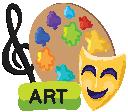

GAMES

INTEGRATED

BHARAT
Bringing creativity and fun into learning by combining music, drama and art with English
Using physical activities, sport and games to make learning active and fun
Cross-curricular and skill linkages to make the learning experience more holistic, joyful and meaningful
Indianess
Texts and tasks are rooted in the Indian context and culture to develop a sense of national pride

TEAMWORK

SDG
Embracing the spirit of mutual collaboration and cooperation while working together or engaging in a guided conversation
Unwavering commitment to generating awareness of a green, peaceful, prosperous, equitable and inclusive world

SEL
Developing the skills to understand and manage emotions, build positive relationships and make responsible choices HANDS-ON
Engaging actively in hands-on experiences to acquire knowledge and skills
HOTS
Tasks encourage higher-order skills such as analyzing, evaluating, problem-solving and fostering deep understanding

The National Curriculum Framework for School Education (NCF), released in 2022–2023, is developed based on the vision of the National Education Policy (NEP) 2020, and to enable its implementation. The NCF provides guidelines for designing school syllabi and textbooks in India. It aims to improve the quality of education by making it more relevant, engaging, inclusive and learner-centric. To achieve this, the NCF has articulated precise Learning Standards through well-defined Curricular Goals and Competency statements. These statements serve to harmonise the syllabus, content, pedagogical practices, and assessment culture, ensuring a cohesive and comprehensive educational experience.
Curricular Goals: Curricular Goals are statements that give direction to curriculum development and implementation. They are derived from Aims and are specific to a Stage in education.
Competencies: Competencies are learning achievements that are observable and can be assessed systematically. These Competencies are derived from the Curricular Goals and are expected to be attained by the end of a Stage.
NCF Page 56
CG-10
Children develop effective communication skills for day-to-day interaction in two languages 1
C-10.1 Develops phonological awareness and blends phonemes/syllables into words and segment words into phonemes/syllables
C-10.2 Understands basic structure/format of a book, idea of words in print and direction in which they are printed, and recognises basic punctuation marks
C-10.3 Recognises all the letters of the alphabet (forms of akshara) of the script and uses this knowledge to read and write words
C-10.4 Reads stories and passages with accuracy and fluency with appropriate pauses and voice modulation
C-10.5 Reads short stories and comprehends the meaning — by identifying characters, storyline and what the author wanted to say — on their own
C-10.6 Reads short poems and begins to appreciate a poem for its choice of words and imagination
C-10.7 Reads and comprehends the meaning of short news items, instructions and recipes, and publicity material
C-10.8 Writes a paragraph to express their understanding and experiences
C-10.9 Shows interest in picking up and reading a variety of children’s books
Note: English has been considered as L1 for this exercise.
English skills and competencies are thoughtfully mapped to ensure a smooth and progressive learning experience. Beginning with basic concepts at the foundational stage, the curriculum gradually incorporates more advanced skills and concepts at the preparatory stage. This structured approach enables learners to build their competencies each year, equipping them with the necessary language and 21st century soft skills as they progress from grade 1 through grade 5.
C-9.1 Listens to and appreciates simple songs, rhymes and poems
C-9.2 Creates simple songs and poems on their own
C-9.3 Converses fluently and can hold a meaningful conversation
CG-9 Children develop effective communication skills for day-to-day interactions in two languages
C-9.4 Understands oral instructions for a complex task and gives clear oral instructions for the same to others
C-9.5 Comprehends narrated/read-out stories and identifies characters, storyline and what the author wants to say
C-9.6 Narrates short stories with clear plot and characters
C-9.7 Knows and uses enough words to carry out day-to-day interactions effectively and can guess the meaning of new words by using existing vocabulary
C-10.1 Develops phonological awareness and blends phonemes/ syllables into words and segment words into phonemes/ syllables
CG-10 Children develop fluency in reading and writing in Language 1
C-10.2 Understands the basic structure/ format of a book, idea of words in print and direction in which they are printed, and recognises basic punctuation marks
C-10.3 Recognises all the letters of the alphabet (forms of akshara) of the script and uses this knowledge to read and write words
C-10.4 Reads stories and passages with accuracy and fluency with appropriate pauses and voice modulation
C-10.5 Reads short stories and comprehends the meaning — by identifying characters, storyline and what the author wants to say — on their own
C-10.6 Reads short poems and begins to appreciate a poem for its choice of words and imagination
C-10.7 Reads and comprehends the meaning of short news items, instructions and recipes, and publicity material
C-10.8 Writes a paragraph to express their understanding and experiences
C-10.9 Shows interest in picking up and reading a variety of children’s books
Note: English has been considered as L1 for this exercise.

Ma has come back home with a baby. Jia and Jai are not happy! They cannot make a noise when the baby is sleeping. But the baby is ALWAYS sleeping!
Theme Page: It shows the theme of the unit


One tiny light flew down!
A short and fun activity that gets learners excited
for the games you can play INSIDE the for the games you must play OUTSIDE.
Jia and Jai are brother and sister. There is someone new at home. They will have to play quietly now and make less noise. Who is this person? Let us
text to set the context and arouse curiosity
In a tree far away, there were some tiny lights.
‘I am a firefly,’ said the tiny light. ‘I glow in the dark!’

‘Will you be my friend?’ asked Tinku.
‘Yes, I will!’ said the firefly.
Something black flew over Tinku’s head. It hung upside-down from a tree.
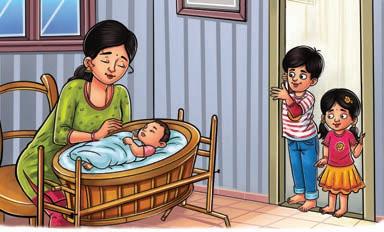
Ma has come back home with a baby. Jia and Jai are not happy! They cannot make a noise when the baby is sleeping. But the baby is ALWAYS sleeping!
They cannot run in the house. They cannot talk at snack-time. They cannot even laugh loudly!
Ma has come back home with a baby. Jia and Jai are not happy! They cannot make a noise when the baby is sleeping. But the
Animated video of the text
‘I am a bat,’ it said. ‘I can fly, but I am not a bird!’
Fireflies light up to talk to each other. They use their glow to send messages.
Oh, no! The baby wakes up! The baby begins to cry. Let’s Read

Read and Respond
‘Will you be my friend?’ asked Tinku. ‘Yes, I will!’ said the bat.
In a tree far away, there were some tiny lights. One tiny light flew down!
But one day, Jia and Jai read a funny story—a very funny story! They to laugh. They laugh loudly!



Did You Know?
‘I am a firefly,’ said the tiny light. ‘I glow in the dark!’
A few leaves moved in the bushes. Someone was hiding! Tinku was terrified at the noise. Out came a fox.
‘Will you be my friend?’ asked Tinku. ‘Yes, I will!’ said the firefly.

Fireflies light up to talk to each other. They use their glow to send messages.
‘I am a fox,’ said the animal. ‘I have big ears, and I can hear soft sounds from far, far away!’

snack-time: time between lunch and dinner when one eats light food starts
1. Fill in the blanks. cooks poha.
Jia and Jai are brother and sister. There is someone new at home. They will have to play quietly now and make less noise. Who is this person? Let us

Something black flew over Tinku’s head. It hung upside-down from a tree.
glow: shine hung: held onto something so as to not touch the ground terrified: very scared


‘I am a bat,’ it said. ‘I can fly, but I am not a bird!’
‘Will you be my friend?’ asked Tinku.
‘Yes, I will!’ said the bat.
Think and Tell
How do Jia and Jai feel when baby wakes up? How do you when you wake someone up a deep sleep?
i Papa ii Mumma iii
Interesting facts related to the topic
Rishika’s family goes on a picnic near a i park ii zoo iii Rishika plays with her at the picnic. i parents ii friends iii
They cannot run in the house. They cannot talk at snack-time
They cannot run in the house. They cannot talk at snack-time They cannot even laugh loudly!
Think and Tell: Comprehension-based questions for teachers to assess learners’ attention and understanding while reading
How did Tinku feel when he heard noises coming from behind the bush?
A few leaves moved in the bushes. Someone was hiding! Tinku was terrified at the noise. Out came a fox.
‘I am a fox,’ said the animal. ‘I have big ears, and I can hear soft sounds from far, far away!’ 16
glow: shine hung: held onto something so as to not touch the ground terrified: very scared
Oh, no! The baby wakes up! The baby begins
Read and Respond: Factual questions for reading comprehension
snack-time: dinner when one eats light food begins: starts
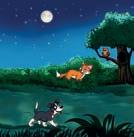
Think and Tell
How did Tinku feel when he heard noises coming from behind the bush?
Tips: Quick tips for learners’ support
But one day, Jia and Jai read a funny story—a very funny story! They start to laugh. They laugh loudly!
d Rishika and her family go home in the i morning ii evening iii
Oh, no! The baby wakes up! The baby begins to cry.
But one day, Jia and Jai read a funny story—a very funny story! They start to laugh. They laugh loudly!
Think and Tell
Think and Tell

snack-time: time between lunch and dinner when one eats light food begins: starts
2. Talk about and answer the questions in class. What does Papa do at the start of the story? Who sits with Rishika at the back of the car?

Read and Respond
How do Jia and Jai feel when the baby wakes up? How do you feel when you wake someone up from a deep sleep?
1. Fill in the blanks.
How do Jia and Jai feel when the baby wakes up? How do you feel when you wake someone up from a deep sleep?
c What do Dada and Dadi do in the car?
d Who brings the ball back to Rishika?
a cooks poha.
Papa ii Mumma iii Raghav
b Rishika’s family goes on a picnic near a

c Rishika plays with her parents
Papa You may look for the answers in the story.
Answer in full sentences.
Put up your hand and take part!
d Rishika and her family go home in the morning
You can write the answers if your teacher asks you to.

2. Talk about and answer the questions in class.
a What does Papa do at the start of the story?

b Who sits with Rishika at the back of the car?
c What do Dada and Dadi do in the car?

c When Aai says that puppies have muddy paws and fur, what do Isha and Nakul say?
d Why do Aai and Baba decide to get a pet dog for Isha and Nakul in the end?

Think and Answer: Questions to help learners to critically analyse the texts

Think and Answer
2. Tinku and his animal friends will meet again. What game do you think they will play? Why do you think it is a good game for them all to play?
2. Tinku and his animal friends will meet again. What game do you think they will play? Why do you think it is a good game for them all to play?



Read the actions of people in the story. Think of the story and tick () what they could be thinking.
Hint Box: hide-and-seek follow the leader races
Hint Box: hide-and-seek follow the leader races
NEP TAGS: To showcase alignment with NEP skills and values
a Isha gave her soft toy puppy a bath in the sink.
I think Tinku should play with his friends. I say so because
i This soft toy is so dirty. I have to clean it.
ii Aai and Baba will see that I can take care of a real puppy.
2. Complete the sentences with the correct relationship words.
Big Idea

b Isha and Nakul made a list of what they needed for a puppy.
i It will need a puppy bed and puppy food.
ii I will let all my friends play with my new pet.
Read the actions of people what they could be thinking. a Isha gave her soft toy
Look at each picture. Fill in the blanks with the words in the box. Then, read the sentences aloud.
Tinku cannot sleep. Write two ideas that you would give Tinku that will help him sleep.
Hint Box: father brother sister mother grandmother
I think Tinku should play with his friends. I say so because . Big Idea
Big Skills: Analysis, reflection and connection-based questions
Hint Box: boots food pool roof
c Isha and Nakul pretended to take Fluffy for a walk.
i I wish we could go to the park.
a She is my . She tells me stories.
a Jai is wearing new
ii I wish we had a real puppy.
Tinku cannot sleep. Write two ideas that you would give Tinku that will help him sleep.

2.
b The birdhouse has a
Can and Cannot
d Aai and Baba told the kids that they had decided to get a puppy.
i This soft toy is so ii Aai and Baba will



Pronounce Well: To develop phonological awareness
Read the words that make long E sounds.
She is my younger . She plays cricket with me.
Pronounce Well Listen to the words here.
Can tells us about what someone or something is able to do.
i I hope they take good care of the puppy!
c Tina is hungry. She wants
For example:
ii I hope they buy the puppy lots of toys.
Alia can climb a tree.
c He is my . He cooks yummy food for me.
Pronounce Well
leap heal reach heat heap seal teach seat cheap meal peach eat
Vocabulary: Exercises to build vocabulary
d The children swim in the .
Cannot tells us about what someone or something is not able to do.
Listen to the words here.
For example:

Underline the words that make the long E sound.
a A few leaves moved in the bushes.
b There is a seal on the beach.
c They will eat cookies and drink tea.

d He is my younger . He paints with me.
Read the words that make long E sounds.
The baby bird cannot fly high.
b Isha and Nakul made a i It will need a puppy ii I will let all my friends
Vocabulary CRASH! The ball breaks the window.
e She is my . She takes me to the park.

d The frogs can leap over the pond.
Go Grammar

a A fish can swim.
leap heal reach ea heap seal teach ea cheap meal peach t


3. Write YES if the sentence is correct and NO if the sentence is incorrect.
Different things make different sounds.
Go Grammar: Scaffolding of grammar concepts along with practice exercises



SMASH: A loud sound of something breaking.
b The tree can grow without sunlight.
THUD: A sound of heavy footsteps.
c Rabbits cannot hop.
CLANG: A sharp, metal ringing sound.
Naming Words
d A cat cannot bark.
Underline the words that make the long E sound.
4. Fill in the blanks with can or cannot
a A few leaves moved in the bushes.
b There is a seal on the beach.
Speak Well
RATTLE: The shaking sound made by loose objects.
Isha and Nakul pretended i I wish we could go ii I wish we had a real
Naming words are words used for people, places, animals, and things. For example:
a Rohan fly like a bird.
cannot
1. Match the sentences and the correct sound words.
b Nisha is good at Maths. She help us.
Practise speaking here.
c They will eat cookies and drink tea.
People: Ma, Jai, Jia, baby
Listen Well: Activity to listen and comprehend



Animals: eagle, frog, elephant Things ball, window, pot grandmother
Ma drops a metal pot.
Places: home, school, park


Choose your favourite thing in the classroom. Hold it in your hands. Talk about it in class. Use three to four sentences.

c Anuj is scared of water. He swim.
d Ostriches fly.
Jai breaks a flower pot.


This is my box of colour pencils. It is very pretty. I use these pencils to draw and colour. I always keep the box in my school bag.

Listen Well

Pa walks down the stairs.
d The frogs can leap over the pond. 9 Chapter 1 • Don’t Wake the Baby!

Listen to the text here.
The baby shakes a noisy toy.
a Nita found a hurt bird.
d Aai and Baba told the a puppy. i I hope they take good ii I hope they buy the
b Nita left the bird and walked away.
Use simple words to talk about the object.
Say the name of your favourite thing.

Listen carefully to the text and write T for True and F for False.


Speak Well: Opportunity to express their ideas and thoughts through independent, pair and group activities
The bird had magical powers.
The bird gave Nita a silver feather.
Use describing words and action words to talk about the thing.
Choose your favourite thing in the classroom. Hold it in your hands. Talk about it in class. Use three to four sentences.
The feather brought Nita's family good luck and happiness.
Talk about why this is your favourite thing.
Talk slowly and clearly.
Write Well
This is my box of colour pencils. It is very pretty. I use these pencils to draw and colour. I always keep the box in my school bag.
Write Well: Opportunity to apply the learnt vocabulary and express their ideas in writing
A thank-you note is a short message or letter to thank someone for their help, kindness or a gift.


In a thank-you note, we write:
Use simple words to talk about the object.
1. Who you are thanking:
Say the name of your favourite thing.
Start with ‘Dear’ and the person’s name.
Use describing words and action words to talk about the thing.
For example: Dear Grandma,

Talk about why this is your favourite thing.
Complete the paragraph
Listen and circle My hobby
Common names Special names Countable and Uncountable naming words
Relationship words Sound words
Factual questions Visualization Making predictions Making connection double oo sound
1. Self and Family Don’t Wake the Baby Huynh Thi Kim Lien Story
Comparing two things My best friend
Listen and choose
Describing words(colour, shape, size, number)
One or more than one
Words with long E soundleap
Factual questions Ordering Visualization Making predictions
2. Friendship Goodnight, Tinku Preethi Nambiar Story
Show and tell Complete a thank- you note
Listen and write true or false
Words in the place of naming words Can and cannot
Sound words Apostrophe (‘s)
Words with ch/sh/ph sound –ch in, sh ip, ph one
Factual questions Identifying characters Identifying problems and solutions Making connections
Rhyming words Adding ‘un’ or ‘dis’ to make opposites
Acting out action words and framing sentences Acrostic poem
Listen and circle
Doing words Using describing words to compare
Word formation- small words from a big word
Words with bl/fl/pl sound –pl ane, fl ag, bl ock
Words related to season
Project 1: A Map of My Heart
3. Kindness The Boy and the Drum Umesh P N Story
Factual questions Identifying character’s actions Making connections Poetry appreciation– completing poem
4. Kindness Kind Kinnu Poem
Factual questions Ordering Making predictions Making connections
Story
5. Nature A Suitable Shell Radha Rangarajan
Factual questions Making predictions
5. Nature The Golden Sun Lenore Hetrick Poem
Project 2: Making a Thank-You Card
Writing
Speaking
Listening
Grammar
Vocabulary
Pronunciation
Comprehension
Type
Author/ Poet
Chapter
Themes
S.No
Story writing
Rhyme time
Listen and respond
Using a, an and the Position words–place and time
Words with similar meaning Homophones
Words with br/dr soundbr oom, dr eam
Factual questions Identifying key events Comparing and contrasting Inferring character’s thoughts
Graphic Story
7. Imagination and Fantasy Roopa and the Bloop
Complete the comic strip.
My routine
Listen and fill in
Using comma to make Lists The simple present The present continuous
Vocabulary from text Healthy habit related vocabulary
Words with fr/gr soundfr og, gr ass
Factual questions Visualization Making predictions
Story
8. Health and Well-Being King Munch and Mr Wise
Complete the story
Ask and answer questions
Listen and sequence
Sentences and questions (do, does, is, are, am)
Joining words–and, or, but
Rhyming words
Factual questions Identifying problems and solutions Poetry appreciation– completing poem
Poem
Animal sound
Animal movement
Words with ou soundr ou nd
Factual questions Identifying characters’ thoughts and actions Making connections
Story
9. Health and Well-Being Yummy Food, Healthy Food
Project 3: Living a Healthy Life 10. Pets Their Fluffy Best Friend
Informal letter
Tell a tale
Story chain
Past tense– using was and were
Animal body parts
Factual questions Making connections Poetry appreciation– completing poem
Poem
Story vocabulary
The Hard and Soft th sound
Factual questions Ordering Making predictions and inferences Making connections
Story
11. Pets I Have Many Pets
12. Folktales The Turtle Who Could Not Stop Talking

1 . Don’t Wake the Baby!
—Huynh Thi Kim Lien





Look at the pictures. Write I for the games you can play INSIDE the house. Write O for the games you must play OUTSIDE. Get Set
Jia and Jai are brother and sister. There is someone new at home. They will have to play quietly now and make less noise. Who is this person? Let us read the story to find out.

Let’s Read

Ma has come back home with a baby. Jia and Jai are not happy! They cannot make a noise when the baby is sleeping. But the baby is ALWAYS sleeping!

They cannot run in the house. They cannot talk at snack-time. They cannot even laugh loudly!
But one day, Jia and Jai read a funny story—a very funny story! They start to laugh. They laugh loudly!
Oh, no! The baby wakes up! The baby begins to cry.
snack-time: time between lunch and dinner when one eats light food begins: starts

How do Jia and Jai feel when the baby wakes up? How do you feel when you wake someone up from a deep sleep?


Ma is angry! ‘Go and play outside!’ she says.
Why is Ma angry with Jia and Jai?
So Jia and Jai take their ball and go outside. They throw the ball. They catch the ball. They kick the ball.
CRASH! The ball breaks a window!
Oh, no! The baby wakes up. And then… the baby cries!
What do you think Jia and Jai will do now?
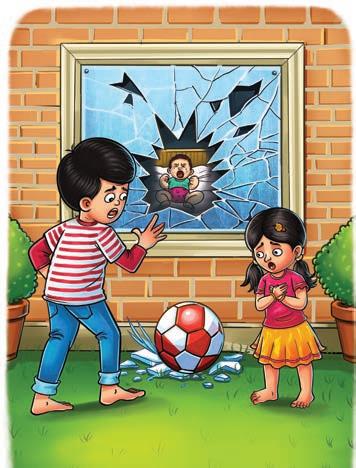
THE BABY WAILS! The baby wails so loudly that the milk bottle breaks. The pot breaks! Another window breaks!
Jia rocks the baby, but the baby keeps crying. Jai sings to the baby, but the baby cries louder.
Now, Jia and Jai start crying too.
crash: a loud sound of something breaking
wails: cries very loudly
rocks: (here) moves softly from side to side
Do you think a baby’s crying can break a bottle, a pot and a window?
Ma comes in. She picks up the baby. She cuddles the baby and sings to the baby. Finally, the baby stops crying.
Now, Jia and Jai understand. ‘We will be quiet,’ they promise.
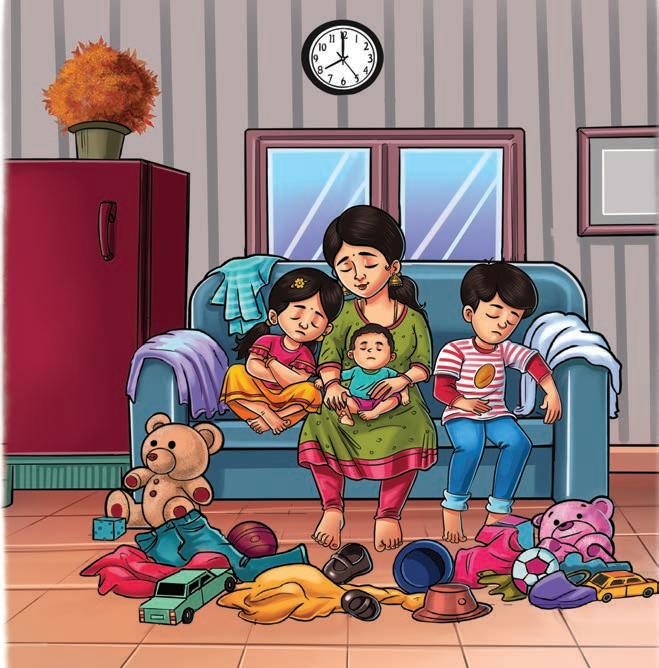
cuddles: holds someone close to show love promise: say you will do something
Think and Tell
How does the baby feel when Ma sings to her?
Listen to all the keywords here.




1. Circle the correct answers.
a Who is new in the house?
i The pet ii The toy iii The baby
b Why should Jia and Jai be quiet?
i Because the baby will wake up and cry.
ii Because Ma is reading a book.
iii Because it is night time.
c What do Jia and Jai do after reading a funny story?
i They go outside.
ii They start to laugh loudly.
iii They make the baby laugh.
d What happens when the baby cries loudly?
i The pot falls on the floor.
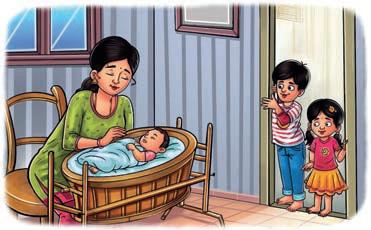
A milk bottle breaks.
Jia and Jai break the bottle.

Match the people and the actions from the story. Action Tells the children to play outside




Laugh loudly at a funny story
Rocks the baby
Cries loudly
3. Answer the questions in one to two sentences.
a What are the things that Jia and Jai cannot do inside the house?
b Why does Ma tell Jia and Jai to play outside?
c Why does the baby cry again?
d What do Jia and Jai do to try and make the baby stop crying?



1. We see and hear a story in our minds when we read it. Read these lines from the story. Tick () what you see in your mind and what you hear.
So Jia and Jai take their ball and go outside.
They throw the ball. They catch the ball. They kick the ball. CRASH! The ball breaks a window!
I see: I hear:
a Ma laughing. a rumble
b the baby giggling. b crash
c the window breaking. c swoosh
Ma comes in. She picks up the baby.
I see: I hear:
a Jai smiling. a munching
b Ma cuddling the baby. b humming
c Jia crying. c wailing



2. Read the sentences. What will happen next? Colour in the pictures to show what the baby will do next.
Actions


Ma cuddles the baby. The baby will sleep. The baby will laugh. The baby will cry. The baby will cry.
Jia makes funny faces.

Big Idea

1. There is a small baby in your house. The baby is crying. Name two things you will do to stop the baby from crying.
2. The baby stops crying and smiles. How will you feel?


Pronounce Well Listen to the words here.
Read the words aloud. soon pool boot hoop moon cool hoot coop noon fool loot loop spoon tool root stoop
Look at each picture. Fill in the blanks with the words in the box. Then, read the sentences aloud.
Hint Box: boots food pool roof
a Jai is wearing new .

b The birdhouse has a .
c Tina is hungry. She wants .
d The children swim in the .

Vocabulary

CRASH! The ball breaks the window.
Different things make different sounds.
SMASH: A loud sound of something breaking.
THUD: A sound of heavy footsteps.
CLANG: A sharp, metal ringing sound.
RATTLE: The shaking sound made by loose objects.
1. Match the sentences and the correct sound words.
Ma drops a metal pot. SMASH
Jai breaks a flower pot. THUD
Pa walks down the stairs. CLANG
The baby shakes a noisy toy. RATTLE boots






2. Complete the sentences with the correct relationship words.
Hint Box: father brother sister mother grandmother
grandmother
a She is my . She tells me stories.
b She is my younger . She plays cricket with me.
c He is my . He cooks yummy food for me.
d He is my younger . He paints with me.



e She is my . She takes me to the park.


Go Grammar



Words
Naming words are words used for people, places, animals, and things.
For example:
People: Ma, Jai, Jia, baby Places: home, school, park
Animals: eagle, frog, elephant Things ball, window, pot






1. Sort the naming words into the correct columns.
Hint Box: Jia home horse milk bottle park kitten baby pot
People Animals Things Places home
Common and Special Naming Words
Common Naming Words
These are any person, place, animal or thing.
Special Naming Words
These are specific people, places, animals or things.
For example: baby, man, river For example: Zam, Mr Sharma, Nile River
Common names start with small letters. Special names start with capital letters.
2. Underline the common naming words and circle the special naming words.
a Ron plays with the ball.
b Zam is sleeping in the cot.


c Mt Everest is a very big mountain.



d The Magic Tree is my favourite book.



Did You Know?
Mount Everest is located on the border between two countries: Nepal and China!


Countable and Uncountable Naming Words.
Countable naming words name things that can be counted. For example:
Uncountable naming words name things that cannot be counted. For example:
We do not say three milk, four water or five sands. We say I have some milk or some flour. three bottles four pots five windows milk water sand
3. Dad is in the kitchen. Help him put things in the correct bag.


Listen Well
Listen to the text here.
Listen carefully to the text. Circle the things the family members get at the fair as you hear them.


During the first reading, listen to the text. During the second reading, circle the things that you hear.


Speak Well

Practise speaking here.
Sit in pairs and talk to your friend about your hobby. Tell them about your hobby in two to three sentences.


Hi! I like singing. I sing songs with my grandmother. What do you like doing?

Hello! I love reading books. I have lots of books at home. My father reads to me every night.
Take turns to talk about your hobbies. Use complete sentences.


Look at the picture of a family. Fill in the blanks.

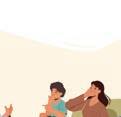


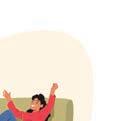

Hint Box: grandpa smile laughs family sofa popcorn
The sits together in the living room. tells a story, and everyone listens to him. The little boy sits on the . He is thinking about something. Mom sits next to him, and she covers her face to hide her . The girl at grandpa’s story. The family is eating together. family


INTEGRATED


Look at the pictures. Circle the pictures of the animals that are awake at night! Get Set
Tinku could not sleep. He decided to go for a walk. What happened next? Let us read the story to find out.




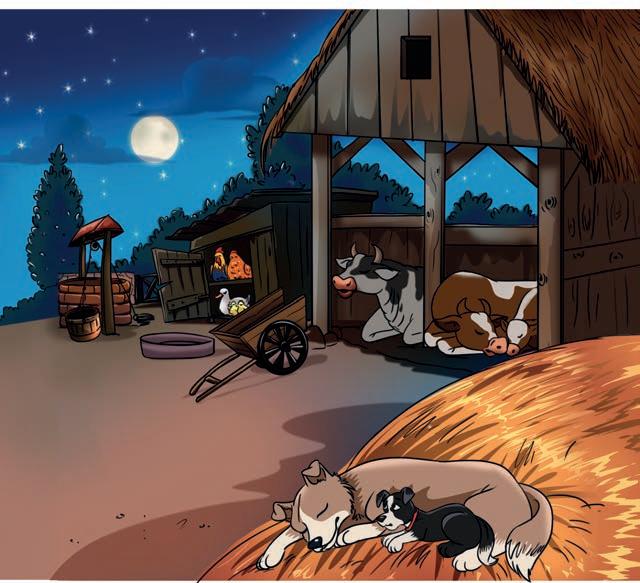



It was night. The moon was bright in the sky. All the animals on the farm were asleep… except Tinku!
He turned left. He turned right. He lay on his tummy. He rolled over, but he could not sleep!
So, Tinku went for a walk. He looked up. He looked down. ‘Is anyone else awake?’ he asked. Let’s Read
lay: to lie down
What kind of animal is Tinku?

In a tree far away, there were some tiny lights.
One tiny light flew down!
‘I am a firefly,’ said the tiny light. ‘I glow in the dark!’
‘Will you be my friend?’ asked Tinku.
‘Yes, I will!’ said the firefly.
Something black flew over Tinku’s head. It hung upside-down from a tree.
‘I am a bat,’ it said. ‘I can fly, but I am not a bird!’
‘Will you be my friend?’ asked Tinku.
‘Yes, I will!’ said the bat.
A few leaves moved in the bushes.
Someone was hiding! Tinku was terrified at the noise. Out came a fox.
‘I am a fox,’ said the animal. ‘I have big ears, and I can hear soft sounds from far, far away!’
glow: shine
hung: held onto something so as to not touch the ground terrified: very scared

Fireflies light up to talk to each other. They use their glow to send messages. Did You Know?
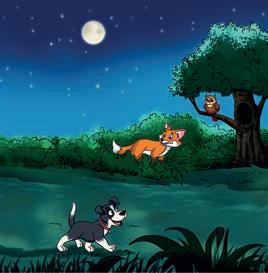
How did Tinku feel when he heard noises coming from behind the bush?


‘Will you be my friend?’ asked Tinku.
‘Yes, I will!’ said the fox.
Two big eyes looked at him from another tree.
‘I am an owl,’ said the bird. ‘I have special wings, so I can fly without making a sound!’
‘Will you be my friend?’ asked Tinku.
‘Yes, I will!’ said the owl.
So the new friends jumped and rolled and played together. But soon, Tinku began to yawn.
‘I am sleepy. I have to go home now,’ said Tinku. ‘Goodnight, friends!’
‘Goodnight, Tinku!’ they said.
yawn: to open your mouth wide to take a deep breath, when sleepy or bored


At night, when we sleep, some animals stay awake and go out to play and find food. They have special eyes to see in the dark! Fireflies, bats, foxes, owls, cats and flying squirrels are all night animals.
Listen to all the keywords here.


Read and Respond

1. Fill in the blanks with words in the box.
Hint Box: firefly walk night bat
walk
a Tinku cannot sleep, so he goes for a .
b The story takes place at .
c Tinku’s new friend that glows in the dark is a .
d Tinku meets a that hangs upside-down from a tree.
2. Write the numbers 1–4 to show the order in which Tinku meets his new friends.


Tinku meets a bat hanging upside down. Tinku meets a firefly glowing brightly.


Tinku meets an owl in a tree. Tinku meets a fox behind a bush.
3. Answer the questions in one to two sentences.
a What did Tinku do when he could not sleep?
b Which new friend had big eyes and wings?
c How many new friends did Tinku make that night?
d Why did Tinku leave his new friends at the end of the story?





1. When we read a story we make a picture in our mind. Read the questions below, imagine and tick () the correct options.
a Where was Tinku when he was trying to sleep?

b What did Tinku see when he looked at the firefly?

c What did Tinku hear when he met the fox?
d How did Tinku feel after making many friends?

2. Tinku and his animal friends will meet again. What game do you think they will play? Why do you think it is a good game for them all to play?
Hint Box: hide-and-seek follow the leader races
I think Tinku should play with his friends. I say so because . Big Idea


Tinku cannot sleep. Write two ideas that you would give Tinku that will help him sleep.
2. Pronounce Well


Read the words that make long E sounds.
Listen to the words here.
leap heal reach heat heap seal teach seat cheap meal peach eat
Underline the words that make the long E sound.
a A few leaves moved in the bushes.
b There is a seal on the beach.
c They will eat cookies and drink tea.
d The frogs can leap over the pond.




One or More than One
When we want to talk about more than one of something, we add the letter -s or -es at the end of the word.
For example: dog dogs fox foxes
Words that end in -ch, -s, -sh, -ss, -o, or -x, take -es to form more than one. brush brushes bus buses bench benches glass glasses tomato tomatoes
1. Match the pictures for ONE and the words for MORE THAN ONE. One More than one potatoes owls trees bushes birds








2. Change the words to more than one. Then, complete the crossword.


Grammar
Describing Words
Describing words tell us more about naming words. We can use them to talk about the colour, shape, size and number of something.
Remember!
Naming words are words used for a person, thing, animal, or place.
Describing words for colours tell us what colour something is.
The bat is black. That is a red fox.
Describing words for shapes tell us the shape of something.
Its eyes are round.
There is a square table.
Describing words for size tell us how big or small something is.
Elephants have big ears.
Look at that tall tree.


Describing words for numbers tell us how many there are.
Two eyes looked at him from a tree.
She has three cats.
1. Underline the describing words in the sentences. Write them in the correct columns.
a A tiny light flew down! b I have a brown dog.
c Look at the round moon. d There are five grasshoppers.
Shape Colour Size Number tiny
2. Complete the sentences with the correct describing words.
Hint Box: five tall orange round
a I saw trees. b My birthday cake is .
c I like to colour in with my crayon. d The teacher gave me stars.
3. Ron visits a garden. Help him describe what he sees.
Hint Box: seven big red green
tall red
I see a ladybug sitting on a leaf. I count butterflies fluttering around the flowers. I like to run around in the garden.


Listen to the text here.
Listen carefully to the text. Tick () the correct answers.
a Where did Ruby and Tim live?
i A garden ii A house iii A forest
b Who are the best friends in the story?
i Ruby and ii Ruby and iii Tim and Tim Sam Jack
c What did Ruby find?
i Apples ii Carrots iii Berries
d What did Tim find?
i A flower ii A tree iii A pond
e Why were Ruby and Tim happy?
i They always shared things.
ii They always ran races.
iii They loved the forest.


Well
Practise speaking here.
Look at the pictures and spot the similarities and differences between them. Talk about one similarity and two differences that you see.

For example:

In the first picture, the eyes of both the unicorns are open.
Look carefully at the pictures.
First think of the sentence and then say it out loud.

Well

Write about your best friend.

My best friend’s name is .
He/She is years old.
He/She is .

His/Her hair is .
Paste a picture of your best friend
His/Her eyes are . We together.
(age) (tall/short) (long/short/black/brown/straight/curly) (big/small/round/oval/brown/black) (two things you do together)

Let us make a beautiful map of our heart. We can show the people we love and admire, and the things we like to do.
What you need for this project:


A sheet of white chart paper
Pictures of friends, family and yourself
Colour pencils, crayons, or markers
A pair of safety scissors
A glue stick
Stickers (smiley faces, hearts, stars, etc.)
Steps
Divide Your Heart:
By:
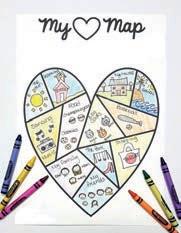
• Draw a big heart in the middle of your chart paper.
• Draw sections in your heart as shown in the image.
• In each section you can write about your favourite friends, hobbies, food, teachers, sports and places. You can write about your family and what you like to do with them.
• Paste or draw pictures of your family and friends.
• Use colour pencils, doodles and stickers to make your heart look colourful.
• Finally, talk about the map of your heart in class. Use the words given below to express your feelings when you talk about it.

You may show your heart in class when you talk about it. You may ask someone in your family to help you.







Get Set

Look at these pictures. How will you help these people? Tell your teacher about it.
An old man carrying heavy bags
A crying baby
A girl caught in the rain
A sad dog
Young Gopi lives in a small village. His biggest wish is to have a drum. Gopi is a kind boy who always helps those in need. Let us read to see how he is blessed.

Let’s Read

Gopi’s mother is going to the market to sell grain. She asks Gopi, ‘What can I get for you?’
‘I want a drum, please Amma,’ replies Gopi.
Amma sells the grain and buys some flour for her house. She has no money left. She feels sad that she cannot get anything for her son.
On the way home, she finds a hollow piece of wood and gives it to Gopi.
Gopi thanks her and runs out to play. He sees an old man trying to light his stove. There is smoke all around him, but no fire.
Think and Tell

What will you do if your mother doesn’t buy what you want?



He goes to the old man and says, ‘Here, Grandpa, your wood is wet. Use this dry wood to light the fire.’
The old man is happy and gives Gopi some bread.
Suddenly, Gopi hears the potter’s baby crying loudly. Feeling sad, he offers the baby the bread, and she stops crying. The potter’s wife is grateful and gives Gopi a pot.
Gopi goes to the river to fetch water. There, he sees an upset washerman.
‘What is the matter?’ Gopi asks.
The washerman replies, ‘I broke my pot and I need to wash these clothes.’
Gopi looks at the pot in his hand and, with a gentle smile, gives it to the washerman.
The washerman gives Gopi a smart, green coat. Gopi wears the oversized coat. He walks along, happily swinging the long arms of the coat.
He sees a singer sitting outside his house, looking sad. ‘What happened, sir?’ Gopi asks.

Think and Tell
‘I have to perform at a wedding but I don’t have nice clothes,’ the singer replies.
potter: someone who makes pots grateful: thankful fetch: get smart: good-looking or grand
What do you think Gopi will do?
oversized: big in size singer: one who plays music well perform: to present a song or a dance in front of people
Gopi looks at his smart, green coat and gives it to the man. The singer gives Gopi a drum. ‘Thank you! You are a kind boy. Take this drum and keep on sharing your kindness with others.’
Gopi’s eyes gleam with joy. He runs home, singing and playing the drum.
gleam: shine brightly
Listen to all the keywords here.





Read and Respond

1. Fill in the blanks.
Hint Box: bread coat wood drum
a Gopi asks his mother to get him a .
b Gopi gives the old man a piece of dry .
c The baby stops crying when Gopi gives her some .
d The washerman gives Gopi a .
2. Read the clues and complete the crossword with the names of people from the story.
Across
1. He is upset about his broken pot.
2. His baby is crying.
Down
1. She brings Gopi a piece of wood.
2. He has to perform at a wedding.
3. Answer the questions in one to two sentences.
a What does Gopi’s mother sell at the market?
b Who does Gopi meet first? What is the person doing?
c Why is the singer sad?
d Why does Gopi run to his house at the end of the story?




1. What lesson can we learn from Gopi?

2. The people in the story have problems. Gopi tries to solve their problems. Complete the table by writing the problems or the solutions that the people have in the story.
People Problem Solution
gives him a hollow piece of wood
Mother She could not buy a drum for Gopi. She .
The old man He could not . Gopi gives him his dry wood.
Potter’s baby
The baby was hungry. Gopi .
Washerman He . Gopi gives him his pot.


Gopi is a kind boy. He helps people who are in need. Think about a time you helped someone.
Who did you help?
What did you do to help?
How did the person feel?
happy pleased overjoyed thankful satisfied



Pronounce Well

Read the words aloud.
shop
Listen to the words here.
sheep fish wash chair chain lunch teach phone photo elephant graph
Look at pictures and say the words aloud. Circle the correct spelling of the words.
sheep / ship
cheese / chest
fone / phone

Vocabulary

chart / chalk
1. We hear many sounds around us. Underline the sound words in the sentences.
a The bee buzzes as it flies past.
b The clock goes tick-tock on the wall.
c The bird chirped tweet-tweet in the morning.
d The leaves rustled in the wind.
Apostrophe (‘s)
An apostrophe is used to show that something belongs to someone. You add an apostrophe + -s (‘s) to the end of a naming word.
The bread belongs to Gopi. Gopi’s bread.
The pot belongs to the washerman.The washerman’s pot. The drum belongs to the singer.The singer’s drum.
2. Fill in the blank with a naming word + ’s to show who it belongs to.
a The cat belongs to Sarah. It is cat.
b The toy belongs to Adi. It is toy.
c The book belongs to Ved. It is book.
d The pencil belongs to Meena. It is pencil.

Go Grammar

Gopi wants a drum. Gopi helps the old man. Gopi wants a drum. He helps the old man.
Mother goes to the market. Mother sells grain.
Mother goes to the market. She sells grain.
The coat is big. The coat is green. The coat is big. It is green.
Gopi and the old man are talking. Gopi and the old man are happy.
Gopi and the old man are talking. They are happy.


Words that are used in place of naming words that are doing the actions are I, he, she, you, it, we and they.
Words that are used in place of naming words that are receiving the actions are me, him, her, you, them, us and it.
Doing the ActionDoing WordsReceiving the Action
Rohan (He) hugs Vivaan. (him)
I saw Kavya. (her)
Kiran (She) missesRohan and Anuj. (them)
1. Tick () the correct word and fill in the blanks.
a went for a walk.
i He ii Him
b The baby bird followed to the park. i us ii they
c looked sad and tired.
i They ii Me
d gave Rohan a bottle of water.
i I ii me
2. Circle the correct words that can be used in place of the naming words.
a The tree is very tall. (They / It )
b The baby birds are sleeping in the nest. (They / Them)
c Nisha wants to play with Anaya. (her / she)
d Adi takes the cat to the vet. (it / we) He
Can and Cannot
Can tells us about what someone or something is able to do.
For example: Alia can climb a tree.
Cannot tells us about what someone or something is not able to do. For example:
The baby bird cannot fly high.
3. Write YES if the sentence is correct and NO if the sentence is incorrect.
a A fish can swim.
b The tree can grow without sunlight.
c Rabbits cannot hop.
d A cat cannot bark.
4. Fill in the blanks with can or cannot.
a Rohan fly like a bird.
b Nisha is good at Maths. She help us.
c Anuj is scared of water. He swim.
d Ostriches fly.


Listen Well

Listen to the text here.
Listen carefully to the text and write T for True and F for False.
a Nita found a hurt bird.
b Nita left the bird and walked away.
c The bird had magical powers.
d The bird gave Nita a silver feather.
e The feather brought Nita's family good luck and happiness. Yes cannot



Practise speaking here.
Choose your favourite thing in the classroom. Hold it in your hands. Talk about it in class. Use three to four sentences.
This is my box of colour pencils. It is very pretty. I use these pencils to draw and colour. I always keep the box in my school bag.




Use simple words to talk about the object. Say the name of your favourite thing.
Use describing words and action words to talk about the thing.
Talk about why this is your favourite thing. Talk slowly and clearly.

A thank-you note is a short message or letter to thank someone for their help, kindness or a gift.
In a thank-you note, we write:
1. Who you are thanking:
Start with ‘Dear ’ and the person’s name.
For example: Dear Grandma,
2. Why you are saying thank you:
For example: Thank you for the new book.

3. Something nice at the end:
For example: You are the best!
4. Sign your name:
End with ‘Love,’ and your name.
For example: Love, Maya
Model Answer
Dear Mom,
Thank you for the new toy car. I love it because it goes so fast. You are the best mom ever!
Love, Raj
Think about a gift that you got from someone. Write a thank-you note to the person who gave you the gift.
Dear ,
Love, (name of the person)
(name of the gift)
Thank you for . I love it because . You are the best ever!
(why you like it) (relationship) (your name)




Get Set

When we are helpful and nice to others, it is called being kind. Circle the pictures that show kindness.
Kinnu is a kind and helpful young boy. Let us read the poem to get to know him.


The sun shines bright, the day begins, Kinnu is up with happy grins!
He brushes his teeth, he makes his bed, Then helps Papa butter the bread.
He spills the milk, but that’s okay, He laughs, learns and wipes it away.
He teaches Ru to lace his shoe, Hugs Mumma tight, says, ‘I love you!’
‘Hello, uncle! How do you do?’
He greets his friends, both old and new!
He listens to his teachers oh so well, He tidies up when he hears the bell!
up: (here) awake grins: a big happy smile spills: (here) messes some milk by mistake

What does Kinnu do after he makes a mistake?
wipes: cleans something by using a piece of cloth
greets: says hello in a friendly way tidies up: cleans up a place to make it neat
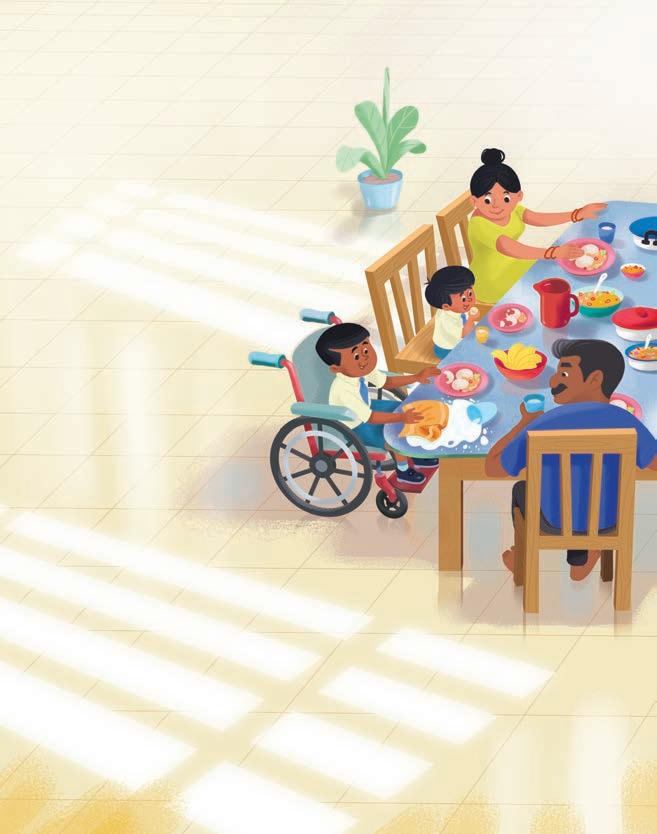

Knocks over blocks while having fun, Says, ‘Sorry!’ and builds another one.
Lunchtime comes, he finishes his food, He says, ‘Thank you!’—He is never rude.
He plays with friends, with a smile so wide, Sees a hurt bird, and stays by its side.
Evening is here, the sky turns pink, He feeds his pet, gives it water to drink.
Then off to bed, he says, ‘Goodnight!’ Kinnu’s kindness shines so bright.
How do you think Kinnu takes care of the bird?
knocks over: makes something fall by mistake feeds: gives someone food to eat
Listen to all the keywords here.

Kind Kinnu
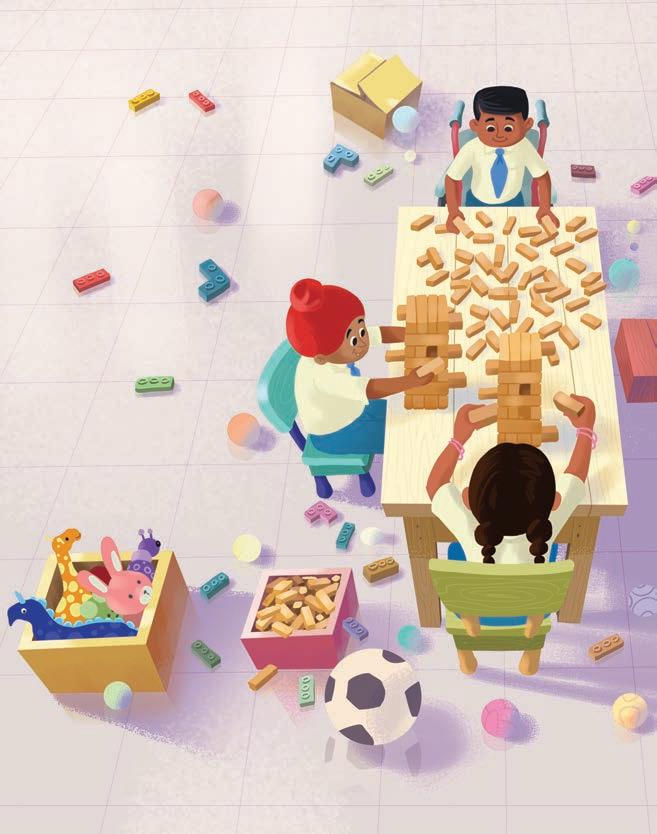


Read and Respond

1. Match the people in the poem and what Kinnu does for them.
People Actions gives water to drink


butters the bread
greets him
helps tie shoelaces
2. Answer the questions in one to two sentences.
a What does Kinnu do when he spills the milk?
b What does Kinnu do at school?
c How does he show Mumma he loves her?
d Why is Kinnu called ‘kind’?




Kinnu helps his family, friends and animals. Talk to your friend about how you can help these people.
father grandparents teachers friend


1. Circle the word that rhymes with the word in blue. bright nose place brick light spill still high lamp stamp block pick look tall clock bread cot head pole mat
Sometimes we can add letters to the beginning of words to make opposites.
un- means ‘not’.
It is unkind to laugh at others. (Here unkind means not kind.)
dis- means ‘not’.
I dislike people who are unkind to animals. (Here dislike means to not like.)
2. Fill in the blanks with opposite of the underlined words.
a The rules of the game are clear to Rohan. They are to Nishita. unclear

b It is fair to share toys with all friends. It is to share toys with only some friends.
c Telling the truth is honest. Telling a lie is .
d Rohan talks about what he likes and .



Rhyming pairs are two words that end with the same sound.
Complete the poem ‘Kindness’ with rhyming pairs.
Hint Box: hand–land way–day right–bright
There once was a little bear named Lou, With a heart so kind and true.
Lou loved to help in every ,
Spreading kindness every .
When Lou saw a friend who fell, He would ask if they were well.
With a warm hug and a gentle ,
Lou spread joy across the .
Kind words were Lou’s special spell, Making everyone feel well.
Helping others felt so , It made Lou’s heart feel .







A beach is a place near the sea. It has lots of sand! We should keep beaches clean. Draw a line to show things that you should throw into the dustbin.

Let us read a story about Mili, a hermit crab. Most crabs have their own hard shells that protect them, but hermit crabs do not have their own shells. So, they have to look for empty shells left by snails and use them as their homes. Let us read how Mili finds a shell for herself.



Mili woke up and fell straight into the sand.
She looked up. The sun was shining, like it did every day. But today, Mili felt hotter and lighter. She wondered why.
How did Mili feel when she lost her shell?
Oh, no! Mili had lost her orange shell that fit her so well!
Mili had no time to lose. She had to find a new shell before it became too hot or a bird gobbled her up!
Mili found a black shell and tried to snuggle into it.
‘Go away!’ an angry voice said. ‘I’m in here, and I need to sleep.’
She left the snail alone and moved along the beach. Let’s Read
shell: a hard cover that animals like crabs use as their home
protect: to keep someone safe from something that can hurt them
wondered: thought about something and wanted to know more about it
gobbled up: ate up very fast
snuggle: to fit comfortably into something

Mili saw a blue shell and ran that way. But it was not a shell. It was a plastic cap, with its bottle hidden in the sand.
‘That won’t fit me!’ Mili mumbled.
What did Mili find?
Mili saw a yellow shell and ran that way. But it was not a shell. A dry lemon lay there, all the juice gone.
‘How can I live inside a lemon?’ Mili moaned.

Mili saw a white shell and ran back. But it was not a shell. It was an egg with the yellow yolk eaten.
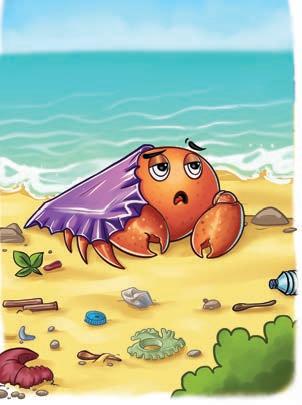
‘This shell will just crumble!’ Mili complained.
Mili saw a purple shell and ran ahead. But it was not a shell. The chocolate had been eaten, the cover thrown away.
‘I thought it was a shiny shell.’ Mili said sadly.
mumbled: spoke very softly and not clearly moaned: made a long, low, sad sound yolk: the yellow part inside an egg crumble: to break into small pieces easily complained: said unhappily

Mili saw a pink shell and stopped. But, it was not a shell. A toe moved, followed by a foot. It was the giant leg of a man asleep on the beach!
‘I think I tickled him!’ Mili laughed.
Mili saw a brown shell and ran up to it. But it was not a shell. The groundnuts had been eaten, and the empty shells thrown around.
‘It will fly away with the wind!’ Mili grumbled.
Mili sees a broken bulb, a wafer packet, and an old button.
But they were not shells.
‘Why are there no shells for me on this beach?’ Mili cried.
Mili saw her friend Toya sliding into a new shell.
‘This new shell fits me better!’ Toya said, leaving behind her old one.
Mili tried the old green shell. It fit her just fine. A happy Mili walked away, hugging her new shell hard!

Think and Tell
Where should you put empty food packets and bottles if you are at a beach? Why?
Did You Know?
Plastic and other waste, in rivers and seas, can make fish and other water animals very sick. Water animals accidentally eat the plastic we throw in the water and this harms them.
grumbled: talked about something in a soft, unhappy voice

Hermit crabs like to live in groups, to feel safe and find food together. Did You Know?
Think and Tell
What do you think Mili should use as her new shell?

Listen to all the keywords here.





1. Write T for True and F for False.
a Mili felt hotter and lighter because she lost her shell. T
b The blue shell Mili found fitted her.
c Mili found a yellow shell that was a dry lemon.
d Mili saw a pink shell of a giant turtle.
2. Answer the questions in one to two sentences.
a Why was Mili looking for a new shell?
b What did Mili find instead of a purple shell?
c Why didn’t Mili use the brown shell?
d What did Toya say when she found a new shell?



1. Look at the pictures and write what Mili finds. Then, number the pictures, 1–6, to show the order in which she finds them.












2. Mili finds a chocolate paper, a plastic cap, and a dried lemon on the beach. What will happen if we throw trash on the beach?


Big Idea

Colour in the pictures that show how we can keep our beaches clean.

Use the recycling bin.
Take our trash home. Throw peels on the beach.

Throw plastic in the sea. Do a beach clean-up. Leave our trash behind.

Pronounce Well

Read the words aloud.
Listen to the words here.
flag block plug flip blanket place float blood plane flower black plant


Read the words and write them. Then, colour the matching picture.


Vocabulary

Circle all the words you can make using the letters in the big word.
Then, match the words and the pictures.

Go Grammar

1. Complete the sentences with the correct doing words in the box.
Hint Box: smiles hugs swim plays
a Mili at Toya every morning.
b Mili her new shell.
c Mili with other animals.
d Mili and her friends in the sea.


Remember!
Doing words tell us what someone or something is doing.



Describing words tell us more about naming words. They describe the shape, size, or colour of the naming word.
We can use describing words to compare. Look at how we add -er to the end of a describing word to compare Mili and Toya.
For example:
• Mili is smart. Toya is smarter than Mili.
• Toya is fast. Mili is faster than Toya.
Sometimes we repeat the last letter before adding -er.
For example:
• The beach is big. The sea is bigger than the beach.
• Mili is hot in her new shell. She was even hotter when she had no shell.
2. Match the words that compare Mili’s old shell and her new shell. Her old shell is… Her new shell is… hard lighter long brighter light harder bright longer
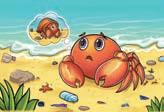
3. Fill in the blanks with -er form of words.
b A snake is (shorter/longer) than a worm. faster
a A cheetah is (faster/slower) than an elephant.
c A tortoise is (faster/slower) than a cat.
d An elephant is (taller/shorter) than a cheetah.


Listen to the text here.
Listen carefully to the text. Circle the correct doing words to complete the sentences.
The horse is running walking going
The cow is grazing lying standing
The ducks are quacking floating swimming
The cat is crawling sleeping lying
The dog is licking holding eating


Practise speaking here.
Choose four action words. Make sentences with the words. Now, act out your sentences as you share them with the class.
Actions words:
• jumping
• swimming
• sleeping
• singing
• drawing

I am jumping. I am dancing.
• running
• eating
• dancing
• laughing
• writing
You may also use other action words.



Read this poem. Crab on the beach, Red shells shining bright, Always moving sideways, Bubbles on their claws, Searching for food at night.
This is a poem about crabs, and each line starts with a letter from the word ‘CRABS!’

Write a similar poem on NATURE. Start each sentence with the given letter.




Tick () the correct pictures.
1. What do flowers do when the sun shines?
Open their petals
Sleep Wake up Get Set
2. What do owls do when the sun shines?



Fly and hunt
Sleep Close their petals
3. What do we do when the sun shines?
It is true that we see the sun every day. But do we need the sun? Let us read the poem to find out!



Great, glorious, golden sun, Shine down on me today, You are the life of all this earth, You and your magic ray. You are the life of bird and plant, All must depend on you.
Shine down, great sun, the whole day long!
Shine from the sky’s blue.

Rainbows are formed by the sunlight shining on water droplets after it rains.
How does the sun make you feel when it shines on you?
glorious: (here) bright and beautiful depend: (here) to wait for the sun’s help


And I will welcome your golden rays, For you mean life to me, And you mean happiness and health, Strength and energy. Shine down, great sun, on flower and field, And never say goodbye. Forever and ever give us your light, From the wide blue sky.

Why do you think the sun is important for plants, animals and people?
forever: always
Listen to all the keywords here.
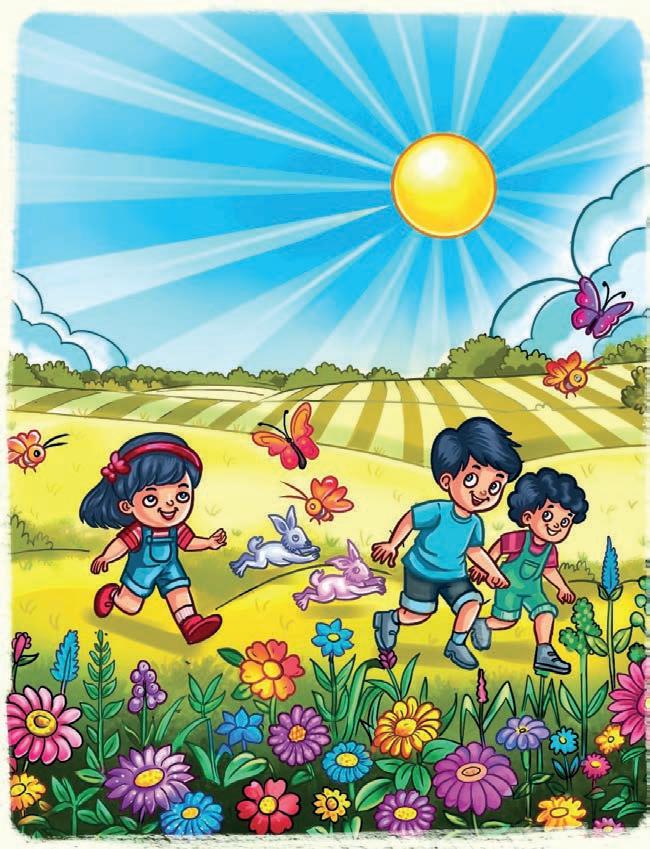




Read and Respond

1. Complete the sentences with the words in the box.
Hint Box: Earth sky flowers happiness sun health
a The poem is about the great, glorious, golden .
b Everything on depends on the sun.

c The poet asks the sun to shine from the blue all day long.
d The sun gives us , , and strength.
e The poet wants the sun to shine on the and fields.
2. Answer the questions in one to two sentences.
a What is the colour of the sun in the poem?
b What does the poet ask the sun to do at the start of the poem?
c Why does the poet welcome the sun’s rays?
d Why does the poet think the sun is so important?

Idea

Imagine that the sun does not come out tomorrow!
Write three sentences about how our days would look different. Then, share your sentences with your friend. sun
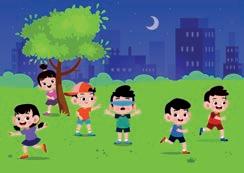

For example: The owls will not sleep. Everything will be dark.



1. Look at the pictures for clues. Circle the words in the puzzle that tell us something about a season.

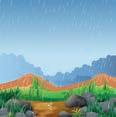

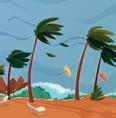
2. We hear different sounds in nature. Match the words and the sounds.





The poet uses words like ‘great’, ‘golden’ and ‘glorious’ to describe the sun. Look at the picture and write five describing words for the sun.
Remember!
Describing words are words that tell us more about naming words.
Hint Box: You can talk about the shape, colour and size of the sun.


































Let us make a special thank-you card. A thank-you card is a way to show someone you appreciate them.
What you need for this project:
One A4-size sheet of paper

A pencil


Crayons or markers
Glitter/stickers
Step 1: Take your A4 paper and fold it in half to make a card. Now you have a front side and an inside.
Step 2: Decorate the Front:
• Think what you would like to thank Mother Nature for.
• On the front of the card, draw a picture related to nature like trees, flowers, birds or the sun.
• Write “Thank You” in big, bold letters on the front.
• Use colours to make your card look pretty.
Step 3: Write Your Thank-You Note Inside:
• Open the card and write a short thank you note inside.
Example of Thank-You Note Create your own lines!
Mother Nature “Thank you, Mother Nature, for the beautiful trees and flowers. I love playing outside!”
“Thank you, Mother Nature, for and . You make the world .”
Step 4: After you finish, you can show your card in class.

You may decorate the inside of the card with drawings, stickers, or any little details you like. Make it special!







It is your birthday. How would you like to decorate the room? Imagine the things you would put in the room. Draw and colour them. Get Set
Roopa has a friend, Bloop, whom she loves a lot. What is so special about their friendship? What do they do when they are together? Let us read the story to find out.


Let’s Read

imaginary: something that you think of but is not real silly: funny and playful
Think and Tell
The Bloop is not clear. Do you think he is Roopa’s real friend or does she imagine him?

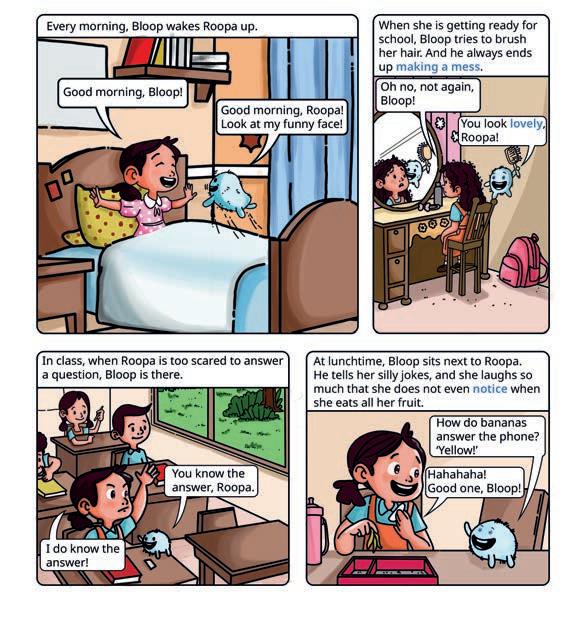
making a mess: making something very untidy
lovely: nice and beautiful notice: see something and pay attention to it

Think and Tell
Can Roopa’s parents also see Bloop? Why?

How do you think Roopa feels when Bloop says he is proud of her?
races: runs to see who comes first watches over: protects and keeps safe



Listen to all the keywords here.
1. Tick () the sentences that are right, and cross () the sentences that are wrong.
a Roopa is Bloop’s imaginary friend.
b Bloop helps Roopa brush her hair.
c In class, Bloop scares Roopa.
d Roopa is afraid of the dark.
2. Choose what happens next in the story.
a Roopa wakes up in the morning, and Bloop makes funny faces at her. i Roopa stays in bed. ii Roopa gets ready for school.


b Roopa and Bloop are in class, and Bloop helps Roopa. i Roopa raises her hand. ii Roopa stays quiet.
c Roopa and Bloop race to the bus. i Roopa wins. ii Bloop wins.
3. Answer the questions in one to two sentences.
a Why is Bloop special?
b How does Roopa feel in the morning when Bloop wakes her up?
c How does Bloop try to help Roopa when she is getting ready for school?
d How does Bloop help Roopa finish her fruit?



1. Bloop is Roopa’s imaginary friend.
a How do you think Bloop is the same as our human friends? You can use these words in your answer: kind, fun and play.
b How do you think Bloop is different from our human friends? You can use these words in your answer: imaginary and pretend.
2. Tick () what Roopa must be thinking.
a Bloop asks to comb Roopa’s hair.
Oh no! He will mess it up again.
Yes, Bloop! Please help me.

b Bloop shares jokes with Roopa.
Oh Bloop, you are so funny!
Bloop, let me finish my food.
c Bloop says, ‘I am so proud of you, Roopa.’
I am so tired.
That is so kind of you, Bloop.


Big Idea



Imagine that you have an imaginary friend. Draw what it would look like.
What name would you give it?
What would you and your imaginary friend do?


Pronounce Well
Listen to the words here.
Read the words aloud. bring broom drum drive brick brook draw drink break brown dress dry


Read the words in the box. Fill in the blanks with the correct words in the box.
Hint Box: bread broom dry brush dress
a Roopa likes to eat bread and jam.
b Bloop says, ‘Wear your pink .’
c Roopa must her wet clothes.
d Bloop helps Roopa sweep with a .
e I my teeth twice a day.


1. Sometimes different words have similar meanings. Match the words that have almost the same meaning.
Homophones are words that have the same sound but different spelling. For example: I have one cookie. I have won the match.
2. Complete the sentences with the similar-sounding words in the box.
Hint Box: bare/bear sun/son flower/flour sea/see
a Grandmother always makes a delicious cake with . She decorates it with a beautiful .
b Nishant is Raghav ’s . He likes to play in the .
c Roopa and her family are at the . Her parents can her play in the sand.
d The cupboard was , so Mama had to go and look for honey.


Go Grammar flour flower
Using A, An and The
• We use a or an before words that name one thing or person. These words do not say which exact thing.
For example:
Bloop and Roopa race to a bus. (We are not saying which bus.)
Roopa ate an ice cream. (We are not saying which ice cream.)
• We use an before words that start with the vowel sounds a, e, i, o, u.
For example: She is eating an apple.


• We use the when we know what we are talking about or when we have already used the naming word.
For example:
Bloop races her to the bus. (Here, we are saying which bus: Roopa’s school bus and not just any bus.)
Roopa ate the chocolate ice cream. (chocolate says which ice cream.) She is eating the red apple from her tiffin box. (Here, we are saying which apple.)
1. Fill in the blanks with the correct article, a or an.
a Bloop is imaginary friend.
b Roopa eats apple.
c Bloop always makes mess.
d Is Bloop elephant?
2. Roopa is telling her friend about a dream. Look at the picture and use the articles, a, an and the, in the sentences. an
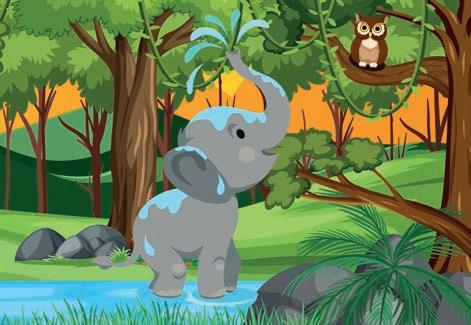
I saw magical forest in my dream. There was owl in magical forest. owl was friends with elephant. elephant had long trunk. Its trunk was like magic wand.
These words tell us where something is— behind, under, above, between or in front of.
For example:
The cat is behind the box.
Remember!
Position words help us understand where things are. They tell us the position or place.
The cat is above the box.
The cat is between the boxes.
The cat is under the box.
The cat is in front of the box.
3. Fill in the blanks with position words of place.
Hint Box: behind between

a The fox is the tree.
b The fox is the two bushes. under


front of above











c The fox is the bush.
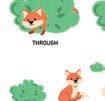


d The fox is jumping the bush.

e The fox is hiding the bush.
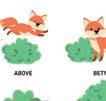

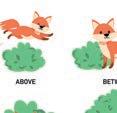

These words tell us when something happens—one, at and in.




AtWe use at for an exact time.Roopa goes to school at 7:30 a.m.
OnWe use on for days or dates.Roopa does not go to school on Sundays.

My birthday is on 7 June.
InWe use in for longer periods of time, like months or years.
We also use in for broad times in a day.
Roopa is going on a school trip in May.
Bloop wakes Roopa in the morning.
4. Fill in the blanks with the correct position words of time (on/at/in).
a Roopa and Bloop decided to go for a picnic 8 May.
b They went for a picnic Saturday.
c They left home 6 a.m.
d Roopa promised Bloop to go again December. on


Listen to the text here.
Listen carefully to the text. Choose the correct answers.
a Who told Lily the secrets of the night sky?
i Emy ii Sparky
b What are the stars for the fairies?
i lamps ii bulbs
c When will the friends visit Sparky?
i next week ii the next day
d What does Emy want to ask a question about?
i aliens ii shooting stars



Practise speaking here.
Recite your favourite rhyme with expression and hand movements in class. Here is a list to help you.
• Twinkle, twinkle, little star…
• Baa baa black sheep…
• Humpty Dumpty sat on a wall…
• Mary had a little lamb…
• Old Mac Donald had a farm…
• Row, row, row your boat…
• Jack and Jill went up the hill…
• London Bridge is falling down…
Have fun singing!

Take your time to remember the words of the rhyme. Sing out loud and in tune.




Let us write an imaginary story!
Look at this picture and complete the story.
Who? There is a bear, some rabbits and a bird.
Where? The story is set in a forest.
What? The bear is wearing glasses and reading a book to the rabbits and the bird.
























Once, there was a bear named Baloo. He loved to read. Every day, he would sit under a tree and read books. The rabbits and the birds would come and listen to the stories.
Look at the picture and write your story in your notebook.
Plan your story.
The names of the boy, the girl and the dragon: Name of the place: List the things they do together:




Tick () your favourite sports activities that help you stay fit!
A king who loved to eat junk food became so unhealthy that he could not even tie his shoelaces. What did he do to solve this problem? Let us read the story to find out.




Once upon a time, in a faraway kingdom, there lived a king named King Munch. King Munch loved to eat junk food. He loved burgers, fries and candy more than anything else. He ate them for breakfast, lunch and dinner. King Munch also hated exercising. Instead, he liked to sit on his throne all day, munching on snacks.
Should we eat junk food every day?
One day, King Munch noticed he could no longer fit into his favourite chair. His clothes were getting tighter, and he was out of breath even when he laughed. But King Munch did not see the problem. He thought it was all just fine. His ministers and doctors were very worried. They tried to talk to him gently.
‘Your Majesty, maybe you should eat less cake and more fruit and vegetables,’ said one minister.
‘But I love cake!’ said the king, looking surprised. ‘Exercise can be fun! You can play badminton or go for a run,’ said a doctor.
But King Munch just laughed and said, ‘Why do I need to change? I am happy just the way I am!’
junk food: food that is not good for us throne: a special chair on which a king or queen sits
munching: eating in small bites while making a sound

Why did the minister ask the king to eat more vegetables and less cake?
out of breath: needing to breathe deeply after exercise worried: nervous or scared about something gently: in a kind way
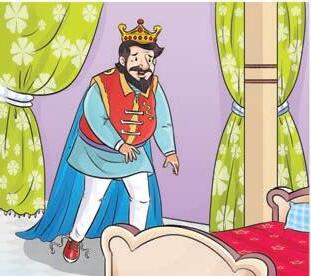
help him put on his walking shoes and started his journey. The walk was tough. King Munch puffed and panted all the way up the mountain. When he finally reached Mr Wise’s house, he was very tired. ‘Welcome, King Munch,’ said Mr Wise with a smile. ‘I can help you, but I cannot leave my house and my books, so you must come here every day.’ King Munch wanted to argue, but he was too tired. So, he nodded and went back to the palace.
Soon, the king could not even tie his shoes or walk up the palace stairs. One day, his minister heard of a wise man who lived outside of town. ‘Your Majesty,’ said the Minister, ‘I know someone who can help you. His name is Mr Wise, and he lives on the other side of the mountain. But no horse cart can go there, so you must walk to his house.’ King Munch sighed but agreed. He really wanted to be able to tie his shoes again. So, he asked one of his servants to

Why didn’t King Munch argue with Mr Wise?
sighed: let out a long breath agreed: said yes to something journey: a long trip tough: hard and difficult
puffed and panted: breathed quickly and with difficulty argue: give a reason for not agreeing nodded: moved his head up and down to say yes


Every day, King Munch walked up the mountain to visit Mr Wise. At first, it was very hard, but each day it got a little easier. He started to notice something amazing. His clothes were not as tight, and he could breathe better. He even began to enjoy the fresh air and beautiful views on his walks. When he reached Mr Wise’s house, they would sit and talk about King Munch’s favourite snacks, laugh and share stories.
One day, after many walks up the mountain, King Munch looked in the mirror and saw that his clothes fit better. He could now tie his shoes, walk up the palace stairs and fit into his throne again. ‘Mr Wise, you have helped me become healthy without me even noticing it!’ King Munch said with a big smile. Mr Wise laughed, ‘Sometimes, the best way to help is to make it fun and simple.’
King Munch returned to his palace with a new habit. He still loved his snacks, but he also enjoyed fruit, vegetables and his daily walks. And so, King Munch lived happily and healthily ever after.

Walking every day keeps our heart active and strong.

amazing: something really great and surprising Listen to all the keywords here.


Read and Respond

1. Fill the blanks with words in the box.
Hint Box: fresh junk tight mountain
a King Munch ate food every day.
b King Munch’s clothes got very .
c Mr Wise lived on the other side of the .
d King Munch began to enjoy the air on his walks.
2. Tick () the correct answers.
a Why did King Munch visit Mr Wise?
i To learn how to bake a tasty cake
ii To get help with becoming healthy
b What did King Munch notice after he started walking every day?
i His clothes were getting tighter, and he could not breathe easily.
ii His clothes were getting looser, and he could breathe better.
c How did King Munch feel about exercising at the start of the story?
i He loved it.
ii He hated it.
d What did King Munch enjoy during his daily walks to Mr Wise’s house?
i The yummy snacks
ii The beautiful views
3. Answer the questions in one to two sentences.
a What did King Munch do all day at the beginning of the story ?
b What did the doctor say King Munch should do?
c What did Mr Wise ask King Munch to do? Why?
d Name three things that King Munch could do when he was healthy.





1. Fill in the table.
Hint Box: calm grand beautiful royal
People Where do they live?
King Munch
Mr Wise
Give two words to describe the place
2. On the left are things that the unhealthy King Munch would do. Write what would change after the King’s habits become healthier.
Unhealthy King Munch What will a healthy King Munch do?
Gets tired and cannot walk up the mountain He will enjoy walking.
Eats only burgers, fries, and candy He will
Cannot bend to tie his shoelaces He will Always lies on his bed He will



A dietician helps people choose yummy and healthy food to keep their bodies strong. Imagine that you are King Munch’s dietician. Circle yummy and healthy food from this list.




















Read the words aloud.





Say the name of the item in the pictures aloud. Then, write the words.

















1. Use words from the story to fill in the gaps.
Charlie Chew has eaten too much food and he is finding the race very . He has not even gone halfway, but he is already out of . Can you hear him and ? junk frock
Hint Box: breath junk puffing panting tough
2. Good habits help us stay happy and healthy. Put each habit into the right box.
Hint Box:
brushing our teeth doing yoga doing homework reading books taking a bath running and dancing
Cleanliness habits
Study habits
Exercise habits

Go Grammar

We use a comma (,) between words in a list so that the reader knows we are naming different things. We do not need a comma before and.
For example:
• King Munch eats chocolate, chips, cookies and pizza for breakfast!
Without the commas we may think the king ate chocolate chip cookies and pizza!
Remember!
We use a capital letter to start a sentence. We end a sentence with a full stop and a question with a question mark.
1. Correct this conversation between the King Munch and Mr Wise by adding commas, full stops or question marks.
Mr Wise: What did you have for breakfast today
King Munch: I had brown bread egg melon and a banana
Mr Wise: I had upma poha and dhokla

The Simple Present is used to state facts.
For example:
• The sun rises in the morning.
We also use the simple present to talk about actions which happen regularly or every day. For example:
Doing words tell us what something or someone is doing. For example: The King walks up the mountain.
• The ministers help King Munch. The words rises and help are doing words. If the action is done by he, she or it, we add -s or -es after the doing word—helps, eats, grows.
We add -es to doing words that end in -ch, -o, -s, -sh, -x and -z.
I watch He watches I wash He washes We do She does We mix He mixes They miss He misses The bees buzz It buzzes
One person
More than one person I eat rice. We (Da and I) eat rice. You (one) eat rice. You eat rice.
He/She/It (Da/Ba/The bird) eats rice.They (Da and Ba) eat rice.
2. Fill in the blanks with the correct form of the doing words.
Hint Box:
a King Munch on his throne every day.
b Mr Wise on the other side of the mountain.
c King Munch up the mountain every day.
d They always about their favourite snacks.
e King Munch’s clothes him well now.

We use the present continuous to talk about actions that are happening right now or at the moment of speaking.
For example:
Look, King Munch is eating healthy food!
The children are studying right now.
The present continuous is formed by adding is/am/are and -ing to doing words.
I am playing.
He/She/It is jumping.
We/They/You are dancing.
3. Choose the correct words to fill in the blanks. The actions are happening now.
a I in my book now.
i is writes ii am writing iii writed
b They around outside.
i are runs ii run iii are running
c Look, Nitesh a beautiful picture.
i is painting ii paints iii is paints
d Ria a healthy salad.
i is eat ii eats iii is eating am writing




Listen to the text here.
Listen carefully to the story and fill in the blanks with the correct words.
a The man asked the villagers for some to eat.
b The man decided to make .
c After the stone, the man added to the soup.
d The second villager got for the soup.
e The villagers learnt a lesson about . Practise speaking here.




Look at this picture. Take turns to tell your teacher what the boy is doing.
Sit with four friends and talk about what you do daily.
Hello friends!
I wake up at 6 o’clock in the morning. First, I get ready for school. Then, I eat my breakfast. After school, I rest for one hour. Next, I do my homework and go to the park to play with my friends. Finally, I go to bed at 9 o’ clock.



Complete the comic strip by writing the conversation between Karthik and Rohit.
Hi Rohit! Why did you not come to yesterday?
Are you now? I had . Doctor says it was due to germs.
Yes! The doctor told me, we should always our hands before .
We should also wash our before cooking.
You are, right Karthik! I will be more careful.
Take care, Rohit. Goodbye!
Karthik. I will see you in .






Healthy food is good for our bodies and helps us grow strong. Fruit, vegetables, grains, pulses, beans, and nuts are all healthy food! Tick () the pictures that show healthy food.





Name your favourite healthy food. Get Set
We love eating sweets and fried food, but these foods are not good for us. They have a lot of sugar and oil which can make us sick. Fruit and vegetables can also be tasty. They help our body and brain to grow.



Healthy food is yummy too, It makes us bright and strong, it’s true!
Apples make our hearts so strong, So we can play all day long!
Ripe bananas, yellow and sweet, Give us energy, oh—what a treat!
Oranges help us fight our cold, Keep us brave and keep us bold!
Carrots help our eyes to see, Bright and sharp as they can be!
Fresh and leafy, spinach green, Helps our blood flow, nice and clean!
Think and Tell
What other healthy foods do you think are yummy and help make us bright and strong?
healthy: things that are good for your body bold: strong and not afraid

Think and Tell
How does cabbage help keep us healthy?
crispy: food that is dry and thin and makes a sound when you bite it
layers: thin pieces of something put on top of each other
crunchy: food that makes a sound when you bite it or press it
creamy: soft and thick
Crispy cabbage, layers deep, Good for our tummies and helps us sleep!
Nuts and seeds are good for the brain. They are healthy and crunchy, sun or rain!
Creamy yoghurt, cool and white, For strong teeth and bellies light!
Healthy food is yummy too, Makes us bright and strong, it’s true! Listen to all the keywords here.

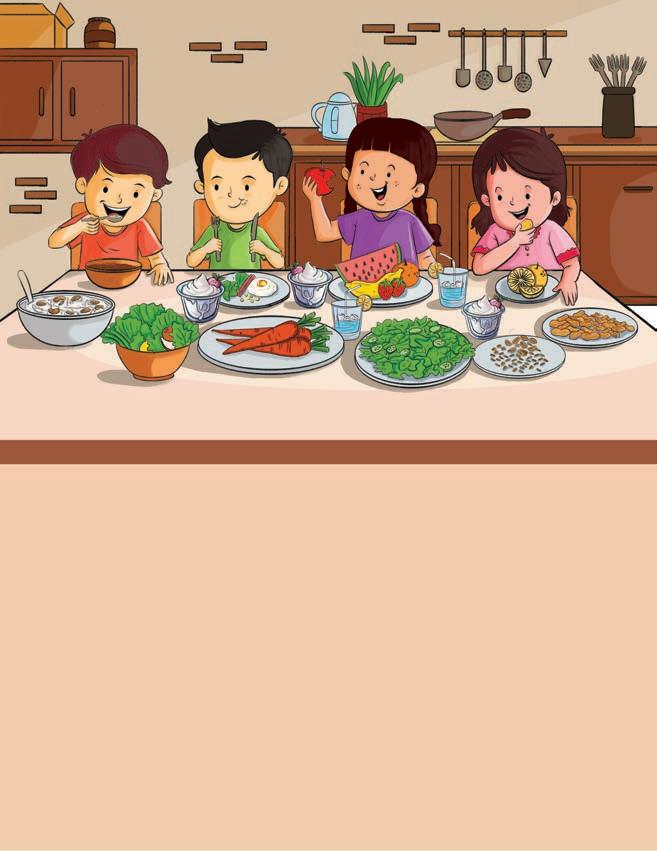



1. Tick () the correct answers.
a Which food makes our hearts strong?
i Cabbage ii Apple
b Which food helps us fight a cold?
i Spinach ii Orange
c Which vegetable helps us see well?
i Carrot ii Onion
d What is good for the brain?
i Apples ii Nuts
2. Answer the questions in one to two sentences.
a Why are bananas a good treat, according to the poem?
b Which vegetable from the poem has layers?
c How does the poet describe yoghurt?
d What do we learn from this poem?
3. Read about the problems that the children are facing. Suggest which foods they should eat to solve their problems.
a Aarna feels very tired and needs more energy to play hockey.
Aarna should eat .
b Batul has trouble with her tummy and cannot eat much.
Batul should eat .
c Darpan feels dizzy and needs something to help his blood flow better.
Darpan should eat .




Let us make a fun and healthy dish with one of the foods from the poem. Decide on a dish and make it with an adult. Then, fill in this table.

The dish I made is . I used from the poem for this dish.
To make this dish, I had to:

In your notebook, write the steps you followed to make the dish.

Vocabulary

Match the words and the pictures that rhyme. Then, write the words.
grain sounds like d



Make the poem longer by writing about other kinds of healthy food! Fill in the blanks with words in the box.
Hint Box: grapes right green heat dal
Juicy , both red and , Full of vitamins, bright and clean! Golden , so warm and bright, Gives us strength and feels just ! Onions, such a pretty treat, Keep us cool and beat the !
Now, write the pairs of rhyming words from the poem.

L iving a Healthy Life
Track your healthy routine for a week.
Steps:
• Follo w a healthy routine every day from Monday to Sunday.
• Tick ( ) the boxes if you followed the routine and cross ( ) if you couldn’t.
• Get it signed b y your parents daily.
• Finally , tell your class how you felt after following the routine daily for a week. RoutineActivityMondayTuesdayWednesdayThursdayFridaySaturdaySunday






RoutineActivityMondayTuesdayWednesdayThursdayFridaySaturdaySunday
Reach school on time
School Routine
Participate in class
Eat lunch
Play during recess
Do homework
Afternoon Routine
Exercise/play outside
Eat a healthy snack
Eat dinner with the family
Evening Routine

Brush teeth before bed
Read a book
Go to bed on time






Set Tick () the things you would like to do if you had a pet.
Isha and Nakul wanted a pet, but their parents always said no. They were sad, but they kept trying to change their parents’ minds. How did they get their parents to agree at last? Let us read the story to find out.



Isha and Nakul are eating breakfast with their mother.
Isha and Nakul: (excitedly) Please, Aai, please! We really want a puppy!
Aai: (smiling but serious) Remember, puppies need to be walked every day.
Isha: (seriously) We can do it! We can take turns, right, Nakul?
Nakul: (nodding) Yes, we can! During lunch, Isha and Nakul talk about having a pet again. But this time they talk to their father.
Isha and Nakul: Baba, we really want a puppy!

Puppies are born with their eyes closed and cannot hear anything! They start to open their eyes and hear sounds when they are about two weeks old.
Baba: Puppies need to be trained. They cannot just chew on everything.
Nakul: (seriously) We will train it! We will be the best puppy trainers ever! In the evening, they all go to the park. They start talking about the pet again.
Isha: (turning to Aai) Aai, we know puppies can make a mess, but we will clean up.
serious: not joking nodding: moving one’s head up and down to show that one agrees trained: taught how to listen and follow rules chew: use your teeth to break food into small pieces
Is it difficult to train dogs not to chew? Why do you think so?


Aai: (smiling) It’s not just cleaning up poop. It’s also muddy paws and fur everywhere.
Isha: We will sweep and we will mop!
Baba: Puppies need a lot of love and a lot of hugs.
Isha: (happily) We will cuddle it! And we will let it sleep on our bed!
Many days pass. Isha and Nakul keep on asking for a puppy—at dinner, while brushing their teeth, and even during bedtime stories.
Isha and Nakul: Please, can we have a puppy?
Baba and Aai: (shaking their heads) No!
Isha and Nakul decide to convince their parents. They find a soft furry toy dog and decide to take care of it as they would do to a real pet.
Nakul: Let’s name it Fluffy.
Isha: (excitedly) Yes, Fluffy!
They bring Fluffy to the dinner table.
Nakul: (pretending to feed it) Fluffy loves carrots!
Isha: (giving Fluffy a bath in the sink) Look, Aai, Fluffy is all clean!
Aai and Baba: (shaking their heads, smiling)
Did you ever want to have something, like Isha and Nakul did in the story? What did you do to get it?

fur: soft hair that covers an animal’s body
mop: clean the floor using a wet cloth
cuddle: lovingly hug someone or something
convince: make someone believe in something sink: a basin with a tap where we wash our hands
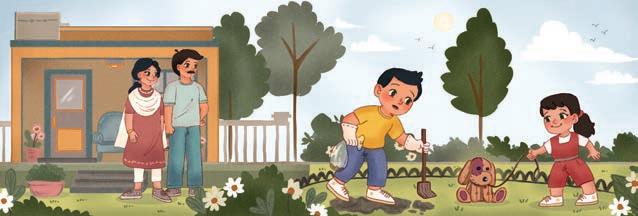
For days, Isha and Nakul take care of Fluffy, pretending to pick up poop and brush its fur.
Isha and Nakul: (to Fluffy) We are practising. Soon, we will have a real puppy.
One evening, Aai and Baba call Isha and Nakul to the dinner table to make a big announcement.
Aai and Baba: (smiling) Nakul, Isha, you have shown us that you can take care of a pet. So, we will get you a real puppy.
Isha and Nakul: (jumping up) Thank you, Aai! Thank you, Baba!
And that’s how Isha and Nakul got their puppy— their fluffy best friend.
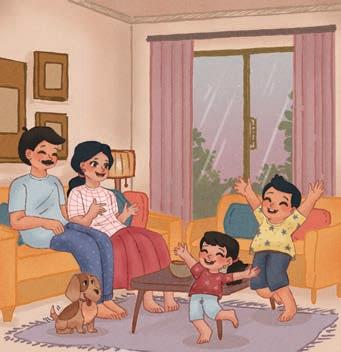
announcement: (here) an important piece of news or information
Listen to all the keywords here.





1. Match the people in the story and their actions.
Isha and Nakul
thought of the name Fluffy.
Aai and Baba asked for a puppy at the breakfast table.
Nakul told the kids they were getting a puppy.
Baba said that puppies need a lot of love.
2. Choose and then write the correct answers in the blanks.
a Isha and Nakul promised to take care of a real pet by .
i teaching it tricks
iii taking it for walks every day
ii leaving it alone
iv going to the pet store
b said puppies needed training.
i Isha ii Baba
iii Aai
i buying lots of toys for it
iii crying for a pet
iv The new puppy
c Nakul and Isha convinced their parents to get them a pet by .
ii showing that they can take care of a pet
iv buying dog food
d The toy dog’s name was .
i Sparky ii Fluffy
iii Fido
iv Bruno taking it for walks every day
3. Answer the questions in one to two sentences.
a What do Isha and Nakul want?
b Baba says puppies need to be trained. What do Isha and Nakul say?
c When Aai says that puppies have muddy paws and fur, what do Isha and Nakul say?
d Why do Aai and Baba decide to get a pet dog for Isha and Nakul in the end?


Think and Answer

Read the actions of people in the story. Think of the story and tick () what they could be thinking.
a Isha gave her soft toy puppy a bath in the sink.
i This soft toy is so dirty. I have to clean it.
ii Aai and Baba will see that I can take care of a real puppy.
b Isha and Nakul made a list of what they needed for a puppy.
i It will need a puppy bed and puppy food.
ii I will let all my friends play with my new pet.
c Isha and Nakul pretended to take Fluffy for a walk.
i I wish we could go to the park.
ii I wish we had a real puppy.
d Aai and Baba told the kids that they had decided to get a puppy.
i I hope they take good care of the puppy!
ii I hope they buy the puppy lots of toys.





If you could have a pet at home, which pet would you like?
What would you name your pet?
Write two ways in which you would take care of your pet.






Pronounce Well Listen to the words here.
Read the words aloud.
mouth sound shout pouch count round proud couch mouse ground cloud bounce house found aloud mound
Write an ou word for the pictures.


Vocabulary

1. Unscramble the letters and write the sounds the animals make.
a The bear gave a low (gorwl) at the deer.
b The duck went (aqukc) as it swam in the pond.
c The kitten began to (urrp) when I petted it.
d I can hear the owls (ooht) at night. growl
2. How do these animals move? Find the words in the word grid and fill in the blanks.

Go Grammar

Sentences and Questions
Remember!
A sentence is a group of words that shows a complete thought. A question is a sentence that asks something. Sentences and questions start with a capital letter and end with a full stop (.) or a question mark (?).


Sentences have two parts.
Isha and Nakul are happy.
Naming part
(What or who the sentence is about)
Doing part (Tells us more about the naming part)
The doing part of a sentence always has an action word. If the action word is are, is or am, always use these words to ask and answer questions.
Sentence Question Answer
They are happy. Are they happy? Yes they are happy. No, they are not.
The puppy is playful. Is the puppy playful? Yes, it is playful. No, it is not playful.
I am lucky. Am I lucky?
Yes, I am lucky. No, I am not lucky.
If you do not see are, is or am, you can use do or does to ask a question.
Sentence Question Answer
They wash the puppy. Do they wash the puppy? Yes, they do. No, they do not.
The puppy barks loudly. Does the puppy bark loudly? Yes, it does. No, it does not.
1. Match the pairs to form sentences. Circle the doing words.
Column A Column B
Fluffy are very cuddly. Puppies is a soft toy.
Aai are ready for a pet.
The children am a lucky girl.
I is worried about her new couch.
2. Use is, am, are, do and does correctly in the questions.
a they in the park?
b Isha and Nakul eat breakfast together?
c Aai worried about cleaning?
d I getting a new pet?
e the puppy drink milk? Are
Words like and, or and but can be used to join two words or sentences.
• AND can join words or sentences.
For example:
Isha wants a puppy. Nakul wants a puppy.
→ Isha and Nakul want a puppy.
Isha brushes her teeth. She goes to bed.
→ Isha brushes her teeth and goes to bed.
• OR is used to give a choice.
For example:
Isha can get a puppy. Isha can get a fish.
→ Isha can get a puppy or a fish. (Isha can get ONE of them.)
• BUT is used to join sentences with opposite meanings. For example:
The children wanted a pet but their parents did not.
3. Fill in the blanks with the correct joining word.
a Nakul (and/but) Isha will feed the new puppy.
b Puppies are sweet (or/but) messy.
c Do you want to play (or/but) go for a walk?
d Baba is tired (but/and) happy. and



Listen Well


Listen to the text here.
Listen carefully to the text and number the sentences in the proper order.
Hint Box: The first and the last sentences are properly ordered, but the others are not.
1 Taking care of a fish tank is easy and fun.
You are now ready to put in fish that can live together.
Next, fill the tank with clean water.
First, you need a clean tank.
Feed your fish once or twice a day.
Then, place colourful rocks and plants at the bottom.
7 Enjoy your new fishy friends!



As you listen to the text, try to remember the order in which things should be done.
If necessary, listen to the text again.

Speak Well
Practise speaking here.
Sit in pairs. Take turns to ask and answer questions about your pets or your favourite animals.
Hi! Do you have pets? Yes, I have a dog. It’s name is Fluffy. Do you have pets? No, I don’t. Which is your favourite animal?
I love rabbits. I like their long ears.
I would chose a fish as a pet. They are quiet and they live in fish tank.
If you could have a pet, which animal would you chose? That is great!



Look at your friend while asking and answering the questions. Nod to show you are listening. Ask them more questions about their favourite animal/pet.

Read the story and write an interesting ending in your notebook.
In a pond, there lived a little duck named Dotty. She wanted to learn how to fly. Every day, Dotty would flap her wings and try to fly like the other birds, but she couldn’t. Dotty was very sad.
To write the ending for this story, think of the following:
• How does Dotty solve the problem?
• What happens at the end of the story to make everything better?




Rearrange the words to name the pet animals. Get Set
A zoo is a place where there are many animals. But what happens when a house becomes a zoo? Let us read the poem to find out!


I have many pets—
My house is a zoo! Do you want to know, The things they do?
My dog—he barks, And he licks my face. He chews all my socks, Then makes a sad face!
My kitten is quiet— She’s just like a mouse. But when I’m asleep, She runs through the house!

Did You Know?
Parakeets can learn to talk—they can learn as many as 100 words!
Which pet would you like to have at home? What will you call it?
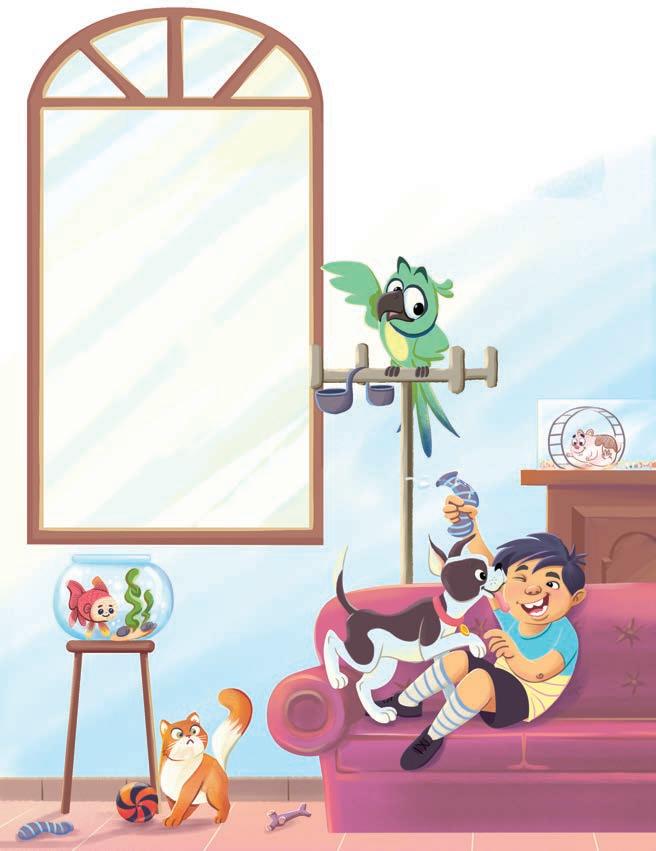

It goes to the tree.
Eating seeds and fruit
And flying so free!
Each morning, a cow Moos outside our gate. And munches our grass
From seven to eight.
And then every night
The owl says, ‘hoo-hoo!’
He thinks he is wise,
But he’s silly too!
I love all my pets— I do love my zoo!
My pets are all silly, And they love me too!
moos: long, deep sound that the cow makes munches: chews food and makes a lot of noise
wise: to be smart and to know what is right and wrong
What is the sound that a cow makes? What does the cow eat?
Listen to all the keywords here.

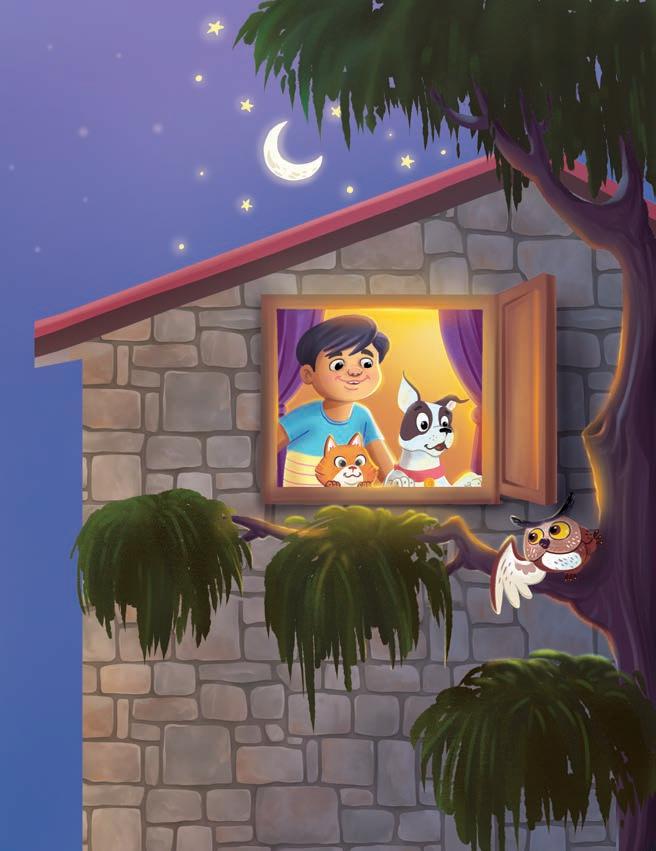



1. Tick () the correct answers.
a What does the dog do in the poem?
i It barks and chews socks. ii It sleeps all day.
iii It flies in the sky.
iv It moos outside the gate.
b What does the kitten do when the speaker is asleep?
i It chews socks.
iii It eats seeds and fruit.
c Where does the parakeet eat seeds?
i In a cage
iii In the tree
ii It runs through the house.
iv It says, ‘hoo-hoo’.
ii In the house
iv Near a pond
d When does the cow munch the grass?
i In the morning
iii In the afternoon
ii All night long
iv All day long
e What sound does the owl make at night?
i woof ii meow
iii moo iv hoo-hoo
2. Answer the questions in one to two sentences.
a Which pet is like a mouse? Why ?
b How does the poet feel about his pets?
c Why does the poet call his house a zoo?
d Is the parakeet in a cage? How do you know?





Think about the ways pets, like cats and dogs, can help people. Write two ways.


Vocabulary

Animals have different body parts like we do. Look at the pictures and fill in the blanks using the words in the box.
Hint Box: whiskers paws wings claws
wings
a The bird uses its to fly.





b The tiger has long on its face.
c The bear uses its sharp to climb the tree.
d The kitten’s soft leave little prints on the floor.



Fill in the gaps to complete the poem. Use the action words in the box.
Hint Box: hop leap waddle run trot fly
In our house, we have a zoo, Pets that do so much, it’s true.
Cats that jump and dogs that , Fish that swim and have some fun.
Cute little bunnies that along, Birds that and sing a song. Ducks that on their flat feet, When I call, they’re ready to eat.
Frogs that with happy feet, Chickens peck and love to eat. Horses , they do not race, Goats that climb all over the place.
In our house, we laugh and play, With pets around, it’s a great day! Every pet moves in a special way, And, in our house, they’re here to stay! run





It is important to listen carefully when someone talks to us. Circle the pictures that show good listening skills. Get Set
Listen to your teacher when she is explaining something.
Talking at the same time as your friend.
Looking at your friend when they are speaking.
Talking on the phone when your friend is speaking.
Once upon a time, there was a turtle who was travelling with his friends. Something happened that changed his life! What happened? Let us read the story to find out.


Once upon a time, in a pond near a hill, there lived a turtle. One day, two young geese came to the pond to look for food.
There, they met the turtle and talked to him. Soon, they became very good friends.
After a few days, the geese said, ‘Friend, we have a beautiful home far away. We are going to fly back to it tomorrow. Will you come with us?’
‘How can I come with you? I have no wings,’ said the turtle.


Turtles can live for a very long time, sometimes more than 100 years! Did You Know?
soon: after a short time

‘Oh, we will take you! But, we can take you only if you promise not to open your mouth or talk at all until we reach home!’ they said.
‘I can do that,’ said the turtle. ‘Please take me with you.’
So the next day, the geese brought a stick with them. Each goose held one end of the stick in its beak.
‘Now hold the middle of this stick with your mouth. Remember, don’t open your mouth or talk at all until we reach home,’ they said again.
Why did the geese ask the turtle to not talk until they reached home?


The turtle opened his mouth and held the stick. Then, the geese flew into the sky.
As they flew, they passed over a village. A group of children looked up and saw them. The children started to laugh and say, ‘Look! The geese are carrying a turtle on a stick! How funny!’
The turtle heard them and said, ‘Well, what’s wrong with my friends carrying me?’
But as soon as he spoke, he lost his grip on the stick and fell to the ground. His shell broke with a crack!
Why did the turtle’s shell break?
The geese could not do anything to help the poor turtle. So, they kept flying. As they flew, they heard people below talking about what happened to the turtle. They said, ‘He couldn’t stay quiet. Now he is hurt.’
passed over: flew above lost his grip: let go of something that he was holding tightly shell: the hard, outer part of an animal’s body

What would you do if you were in the place of the geese?
Listen to all the keywords here.




1. Write True or False.
a The turtle became friends with two ducks.
b The geese did not want the turtle to talk during the journey.
c The turtle fell because he was too heavy for the geese to carry.
d The turtle’s shell broke when he fell to the ground.
2. Put the events in the correct order by numbering them 1–5.
a The geese told the turtle to hold onto a stick with his mouth.
b The turtle talked and fell, breaking his shell.
c The turtle met the geese and they became friends. 1
d The children laughed at the turtle because the geese carried him.
e The geese asked the turtle to travel with them to their home.
3. Answer the questions in one to two sentences.
a Where did the geese want to take the turtle?
b Why did the turtle say he could not go home with the geese?
c How did the geese carry the turtle?
d Why did the turtle fall?



1. At the end of the story, the turtle fell and broke his shell. What do you think the turtle learnt from this?

2. Imagine that the children did not laugh at or tease the turtle. What do you think would have happened next? Answer in two to three sentences.



In the story, if the turtle had listened to the geese, he would have been safe. Like the turtle, we must also listen to others and follow rules to stay safe. Can you think of some rules that keep you safe in the places given below?



• Put your fingers lightly on your throat.
• When you say the hard th sound, like in this or that you will feel your throat moving a little.
• When you say the soft th sound, like in three or bath, there is no movement.

Read the words aloud. the that they these father mother
Soft th
Hard th thief thick teeth earth mouth bath
Say these words aloud and write them in the correct th group.
soft th as in three - hard th as in that -

Vocabulary

Read the meaning and unscramble the words. In your notebook, use the words to make sentences of your own.
a Something we listen to or read. (TOSRY)
b The people or animals in a story. (HCARTACER)
c Another word for stories. (LATES)
d Colourful drawings in books. (PCITRUES) Earth think thief weather




We talk about a thing in the present when it is a fact or happens regularly. We talk about a thing in the past when it happened at a time before the present, like yesterday or last year.
I am in Grade 2.
Last year, I was in Grade 1. My brother is in Grade 5. My brother was in Grade 4. We are in the same school. We were in the same school. I play cricket. Last year, I played football.
We use was and were when talking about the past. To get was and were right, you have to know WHO the sentence is about. For example:
• I was at the pond near the hill.
• The turtle (He) was in a pond.
• The goose (She) was there.
• It was a pretty pond.
• The geese (They) were friends with the turtle.
We were
They were
• You were also at the pond. (You can be one person or more)
• We were also there. I was… He/She/It was… You were
1. Choose the words from the box that can be used instead of the underlined words.
Hint Box: We They He She It
a Myra was on her way to school when Myra saw a strange thing.
b Two geese were in the air. She
c Mr Turtle was on the ground.
d My friend and I were worried.
e The shell of the turtle was cracked.
2. Use was or were to fill in the blanks.
a The merchant angry.
b Birbal and he friends.
c A thief in the merchant’s house.
d Birbal’s plan clever.
e My friends and I there when the thief was caught.
3. Rewrite the story starting with the words given. Change the underlined words into the past.
A poor woodcutter saves a snake in the forest. The snake is so happy, it gives the woodcutter a magic purse. Every time he opens the purse it is full of money. The man and his wife are rich and help others.
One day long ago, a woodcutter saved a snake in the forest. The snake was
Remember!
We add -ed to change doing words into the past tense.




Listen to the text here.
Listen carefully to the start of the story. Each one of you will add one sentence to the story to make it more interesting. So, do not forget to listen to your friends!
‘Once upon a time, there was a puppy. The puppy loved to play in the garden. One day, the puppy found a shiny, red ball...’

Listen carefully to the first part of the story.
Think about what could happen next in the story.




Practise speaking here.
Sit in pairs. Unscramble the sentences and rewrite the story. Read the story aloud to your partner.
a went to a rich man to complain Birbal
A rich man
b the man’s someone in a house was thief

c gave everyone Birbal a stick
Birbal
d the thief’s he said stick grow would 2 cm
He said
e Birbal found the next morning the thief
The next morning
f had cut the thief off 2 cm his stick
The thief .



Speak clearly.
Look at your partner when you talk.
Speak slowly and don’t rush. Take your time to tell your story.

Write Well
An informal letter is a letter we write to someone we know, like our family or our friends.
Model Answer
123, Block B
Raj Garden Road
Hyderabad 123451
1 June 2025
Dear Sneha,
How are you? I hope you are doing well. I recently read a story ‘Rapunzel’. Rapunzel has long, magical hair. She is locked in a tower. A prince finds her and helps her. They fight the witch, and Rapunzel and the prince live happily ever after.
Please also share a story you have read. I will wait for your reply.
Love, Avinash
Your home address with the pincode
Date of writing the letter
Greetings
Body, the main part of the letter Final lines
Closing and your name


Fill in the blanks using the correct phrases to complete the letter to your friend asking to read together.
Hint Box: How are you? the best for being my friend you have a great day read together again soon
1/26, Amaar Block Banglore 134567
(date)
Hi , (name)
Remember when we used to read stories together? Recently, I read a story called . It is about . Let’s . Thank you . You are . I hope . Your loving friend, (your name) (story name) (what the story is about)
Parent’s Name
Student’s Name
Criteria:
Mark Green for Can Do • Mark Orange for Getting There
Mark Blue for Needs Help
Middle of the year
End of the year Parent Teacher
Beginning of the year
Listens to stories and poems with attention
Teacher’s Name
Date
Learning Outcomes
Listening
Understands and follows simple steps and instructions Focusses on the speaker or activity for 10–12 minutes
Describes people, objects, experiences and emotions
Speaking
Participates in simple conversations Expresses basic ideas and thoughts using simple sentences Uses simple vocabulary appropriately when speaking
Reading
Reads a text aloud with proper pauses and expression Understands the stories/poems/plays read Answers questions based on texts read Reads a variety of children’s books
Blends sounds and pronounces known and new, grade-level words using phonics
Writing
Writes sentences and short paragraphs clearly and accurately Uses simple vocabulary appropriately when writing Writes neatly and forms letters correctly
Spells words learnt based on sound patterns
Shows a positive attitude towards learning
Work Habits
Listens and follows instructions Completes work on time Expresses feelings and doubts Takes responsibility for work
Accepts feedback and makes improvements
Track your reading for two weeks. After that, talk to your friends about your favourite books.
Steps:
• Spend 20–25 minutes daily reading a book. Fill in the table for two weeks.
• After two weeks, talk about the book you liked most. When talking about your favourite book, include the following information:

• Name of the book and the author.
• Share who the main character is.
• Tell your friend why you liked the book.
• Talk about the most interesting part of the book.
• Keep reading and filling in the tracker for the rest of the year.
• Even if you miss a day or two, do not give up.
My favourite book is Room on the Broom by Julia Donaldson. It is about a kind witch who helps animals and makes new friends as she flies on her broomstick. I like this book because it has rhyme and teaches the importance of kindness. The most fun part is when the witch’s friends work together to save her from a dragon.
Note: There is a fun reading list at the end of the Coursebook.


Speak slowly and clearly.
Show the book to your friend.
Use simple sentences.
Listen to your partner when they share.



Have fun sharing and discussing your favourite books!
The witch’s friends work together to save her from a dragon
Julia Donaldson A witch and her animal friends

DateDayName of the
26/8/2024MondayRoom On the Broom



1. When Do Hippos Play? by Daniel Errico
https://bit.ly/dohippos
2. Pass It On by Marilyn Sadler
https://bit.ly/passmarilyn
3. Who Let You in My Book by Daniel Errico
https://bit.ly/letdaniel
4. Mr Mckay – The Winter Coat Thief by Daniel Errico
https://bit.ly/mrmckay
5. When Sheep Cannot Sleep by Satoshi Kitamura
https://bit.ly/sheepsatoshi
6. When Will I Read? By Miriam Cohen
https://bit.ly/bymiriam
7. Morris the Moose by Bernard Wisemen
https://bit.ly/morrisbernard
8. Scaredy Squirrel Makes a Friend by Melanie Watt
https://bit.ly/squirrelfriend
9. Frog and Toad Are Friends by Arnold Lobel
https://bit.ly/froglobel
10. The Tiger Who Came to Tea by Judith Kerr
https://bit.ly/tigerkerr
11. Gajapati Kulapati by Ashok Rajagopalan https://bit.ly/gajapatiashok
12. The Day the Crayons Came Home by Drew Daywalt
https://bit.ly/daydrew


13. Donut Feed the Squirrels by Mika Song
https://bit.ly/mikafeed
14. Giraffes Can’t Dance by Giles Andreae and Guy Parker-Rees
https://bit.ly/dancegiles
15. Library Lion by Michelle Knudsen
https://bit.ly/libraryby
16. Why the Cricket Chirps by Daniel Errico
https://bit.ly/chirpsby
17. Where the Wild Things Are by Maurice Sendak
https://bit.ly/wildsendak
18. Tally O’Malley by Stuart J. Murphy
https://bit.ly/tallymalley
19. Ocean Life by jill Mc Donald
https://bit.ly/lifejill
20. A Day at the Airport by Richard Scarry
https://bit.ly/dayairport
Note: Read-alouds are fun! Now that you can read well, visit the library to find more books to read. Happy Reading!
Reading is to the mind what exercise is to the body. — Joseph Addison
Uolo wishes to thank the following entities for granting permission to use the copyrighted materials.
1. Don’t Wake the Baby! (English), translated by Alisha Berger, based on original story Suỵt! Em Bé Đang Ngủ (Vietnamese), written by Huynh Thi Kim Lien, illustrated by Huynh Thi Kim Lien, published by Room to Read (© Room to Read, 2015) under a CC BY 4.0 license on StoryWeaver. The names and few other edits have been made by Uolo EdTech Pvt Ltd for use in this textbook.
2. Goodnight, Tinku! is written by Preethi Nambiar. © Pratham Books, 2014. Some rights reserved. Released under CC BY 4.0 license.
3. The Boy and the Drum is written by Umesh P N. © Pratham Books, 2015 Some rights reserved. Released under CC BY 4.0 license. The play has been transformed into a story with some edits by Uolo EdTech Pvt Ltd for use in this textbook.
4. A Suitable Shell is written by Radha Rangarajan. © Pratham Books, 2018. Some rights reserved. Released under CC BY 4.0 license.
Uolo team has applied for permission to use The Golden Sun written by Lenore Hetrick. Acknowledgement for the text will be made in the future editions of the book.
Every effort has been made to trace the copyright holders and to obtain the permission for the use of copyright material. Where the Publishers have not heard from them at the time of going to press, the Publishers would be grateful for any information that would enable them to appropriate acknowledgement in future reprints/editions of this book.


Introducing Ignite, a thoughtfully-crafted ELT programme designed especially for 21st century learners. In keeping with the National Education Policy (NEP) 2020’s focus on holistic education, Ignite provides opportunities for learners to hone their language skills as well as other 21st century skills. This programme offers a comprehensive language-learning experience supporting the all-round development of learners in line with the learning outcomes of the National Curriculum Framework (NCF) 2022.
• Coursebook
• Workbook thematically aligned with the Coursebook
• Uolo App
• Teacher Guide
• Diverse Literature Compilation of rich literature set in local and global contexts to expose learners to different cultures and build national pride
• Recommended Reading List A suggested reading list and a reading tracker to foster the culture of reading and sharing
• Experiential Projects Opportunities to apply language skills to prepare learners for reallife challenges
• Progress Tracker Tool to empower parents and teachers to track student growth, highlight skill gaps and support year-round development
• Skill-Based Assessments Continuous and comprehensive assessments tailored to promote competency-based learning, along with model papers to enhance teacher support
Uolo partners with K-12 schools to provide technology-enabled learning programs. We believe that pedagogy and technology must come together to deliver scalable learning experiences that generate measurable outcomes. Uolo is trusted by over 15,000+ schools across India, Southeast Asia and the Middle East.
ISBN 978-81-980680-5-7
